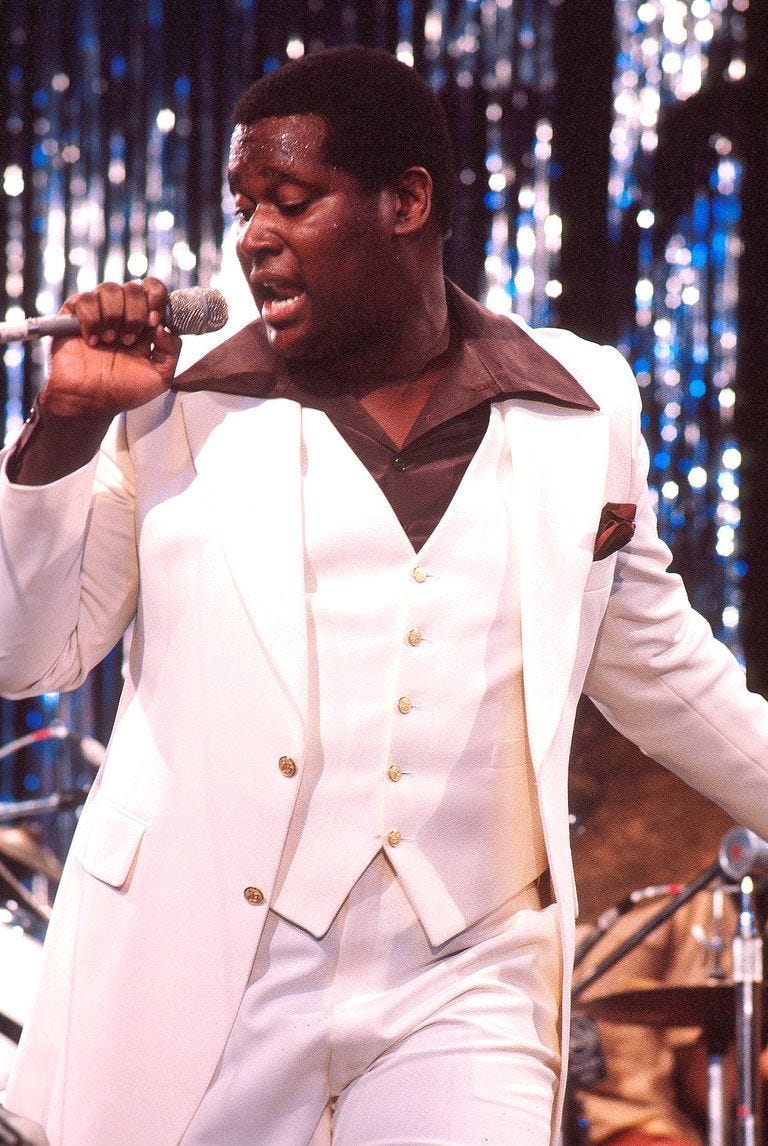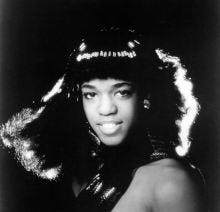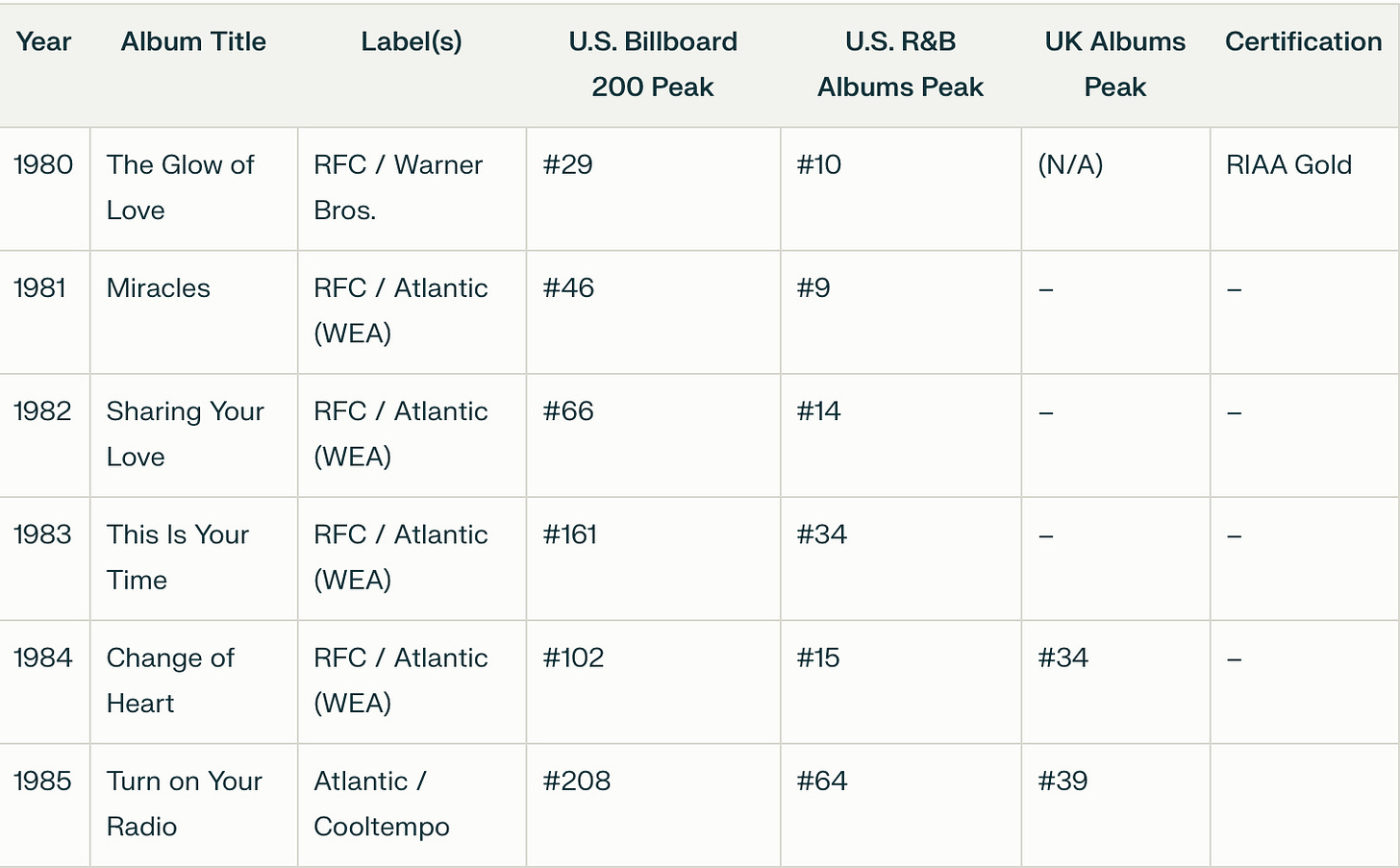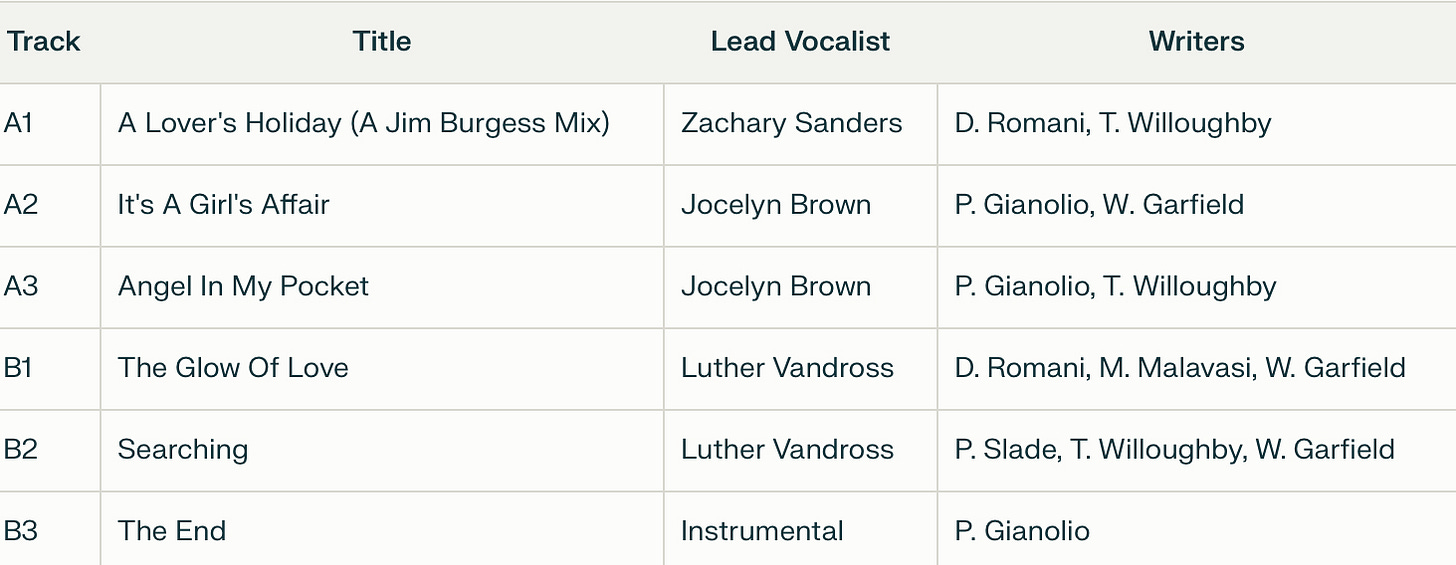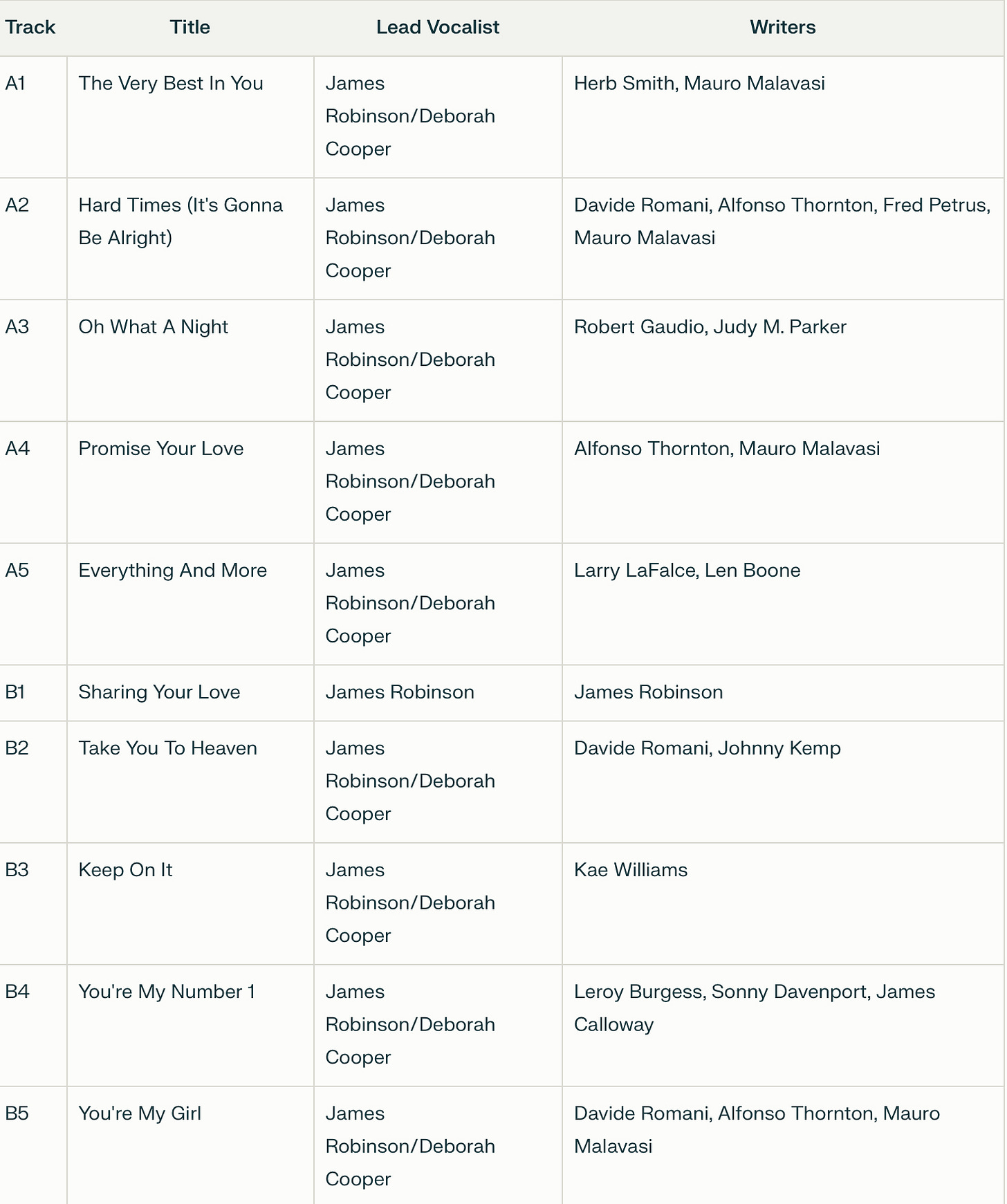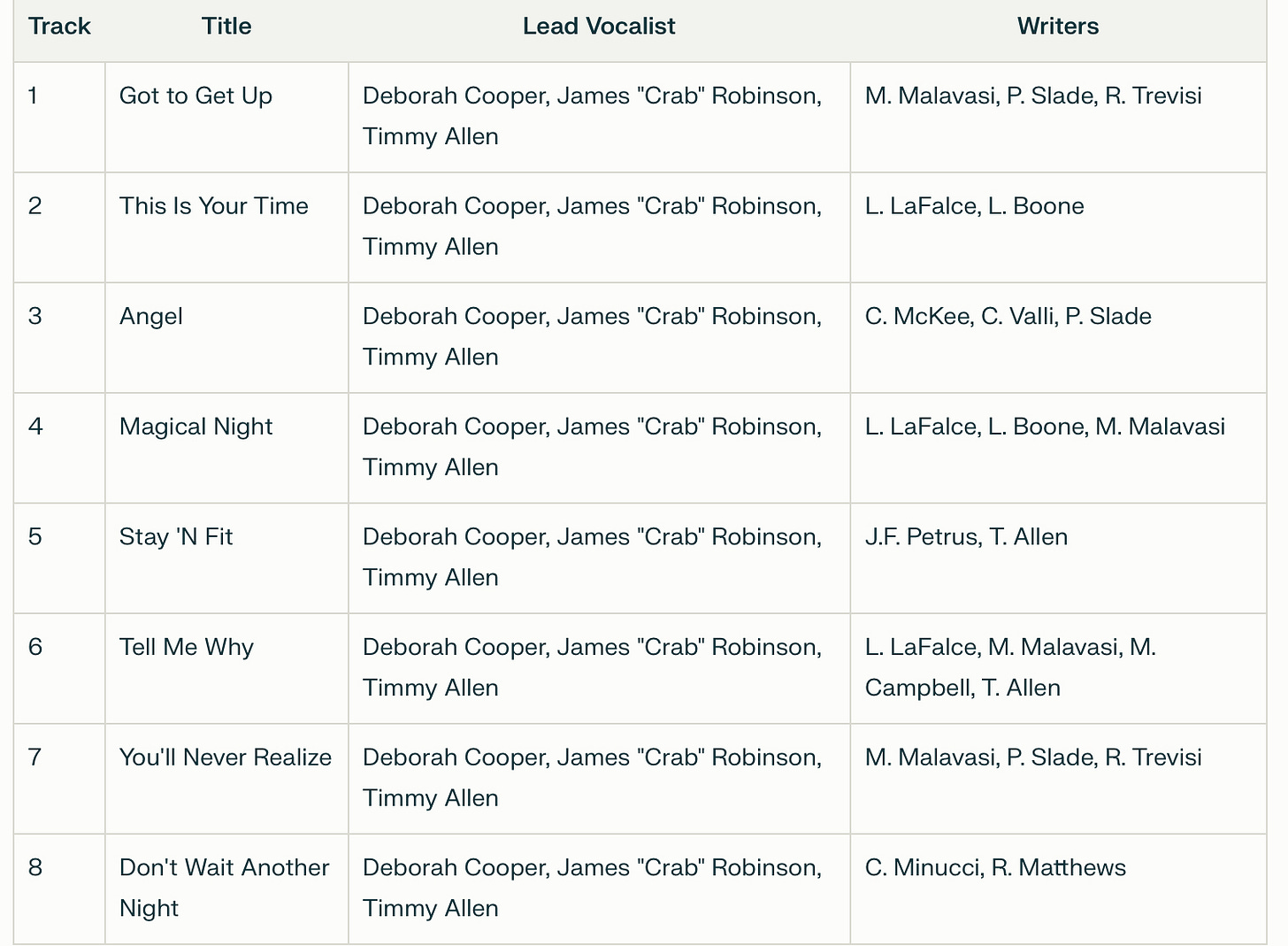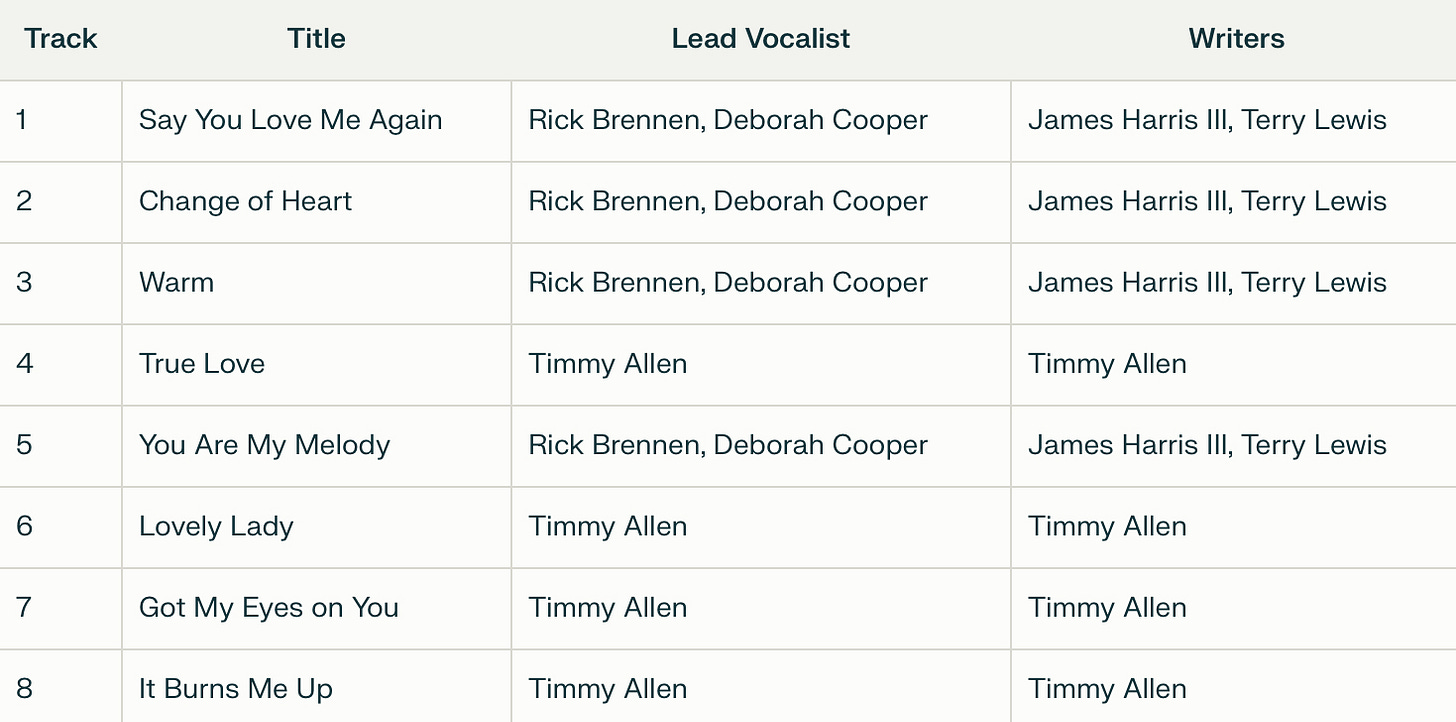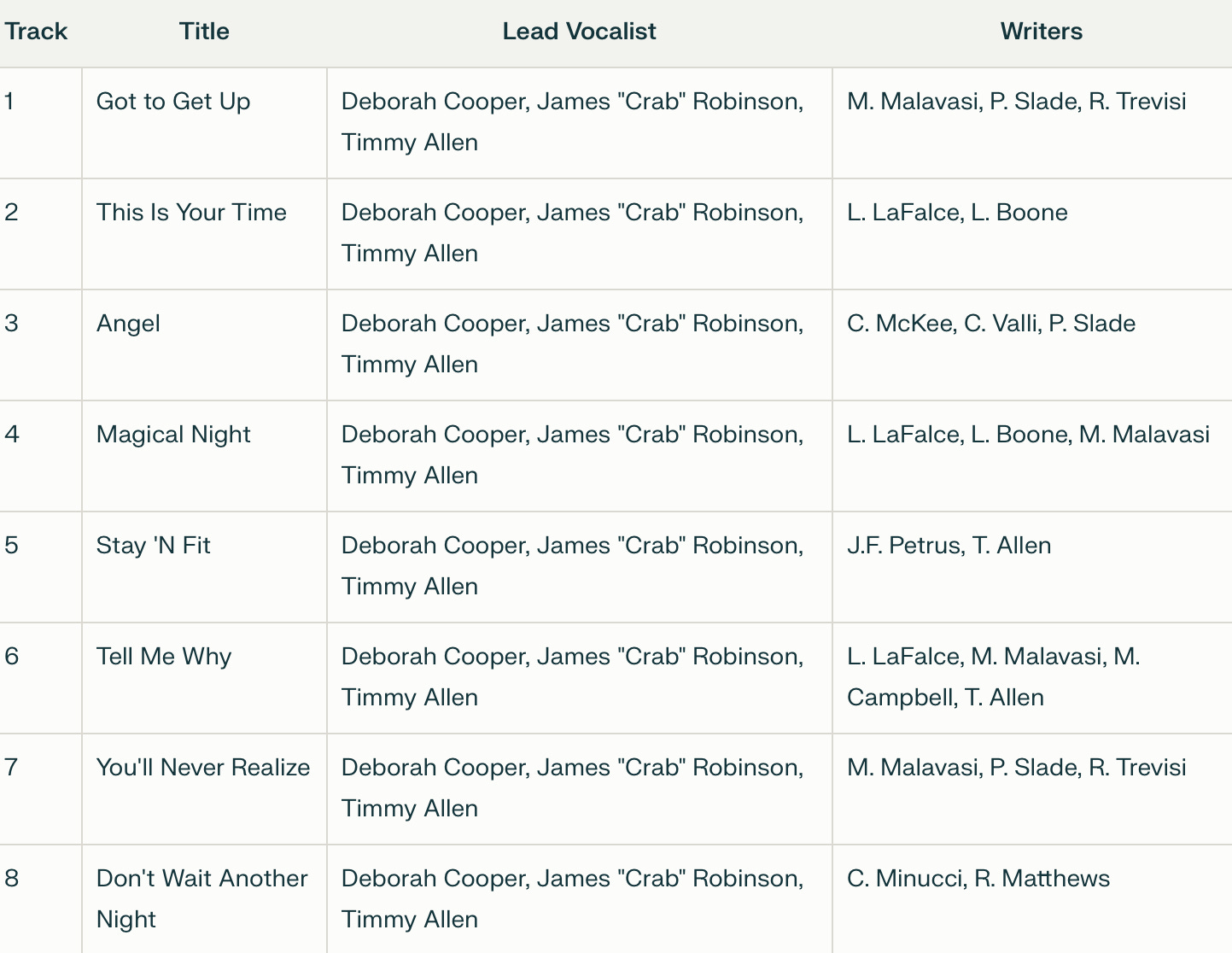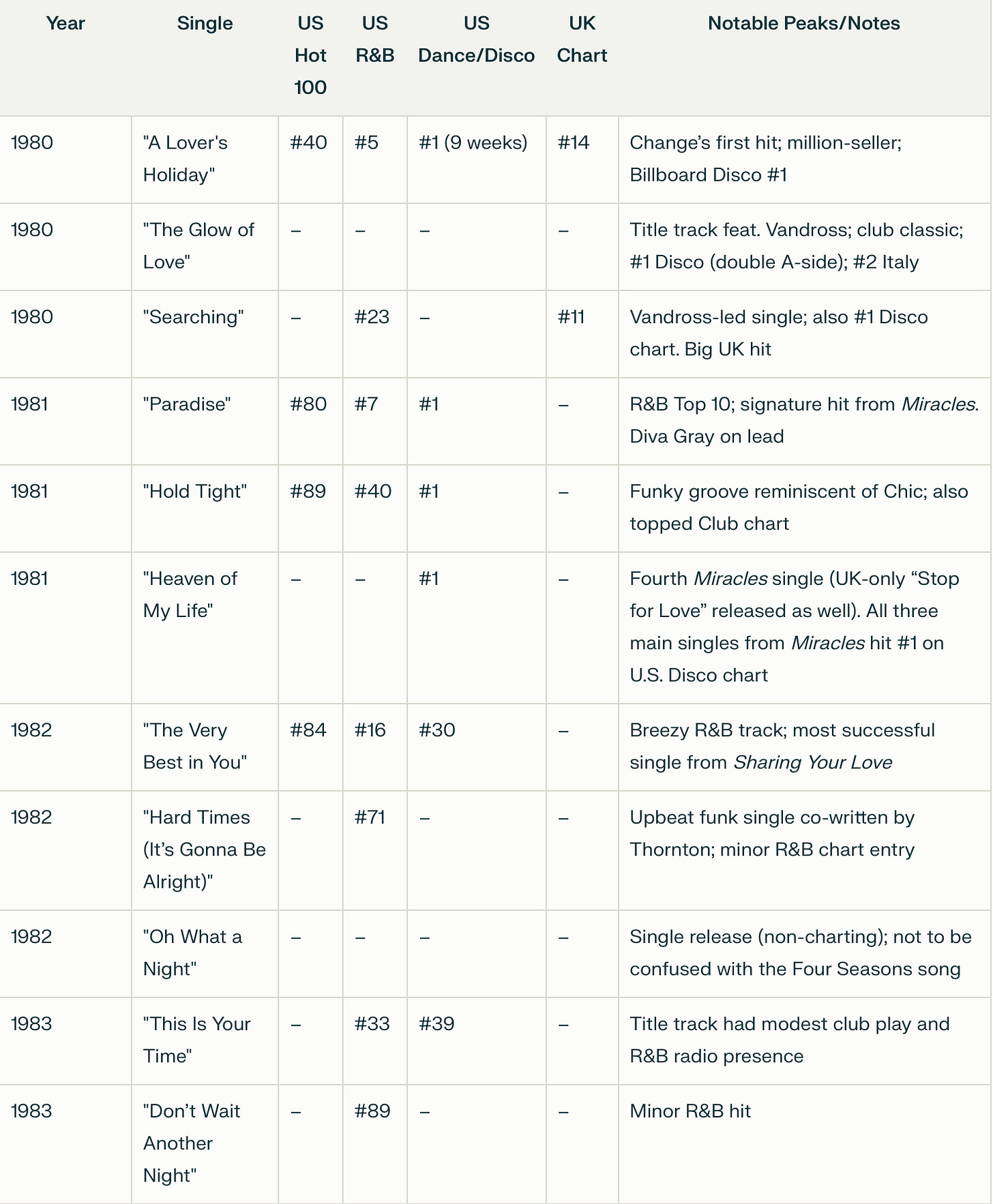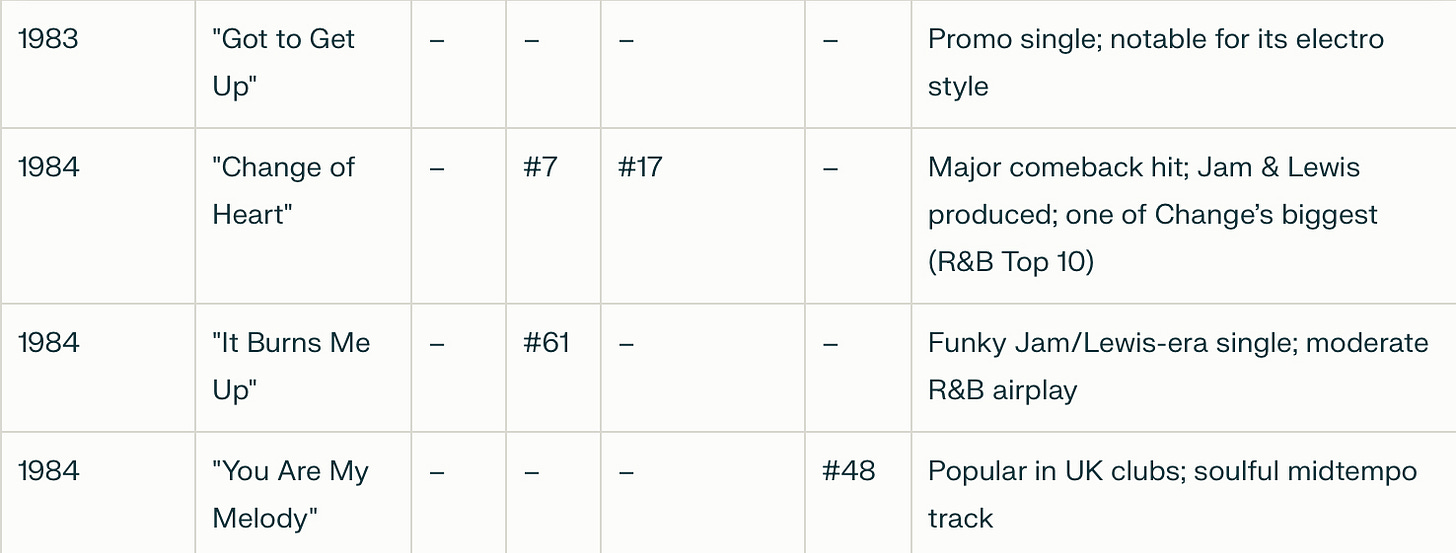Change: The Italian-American Post-Disco Soul/Funk Innovators
Introduction
Change is an Italian–American post-disco music ensemble formed in 1979 that became known for its sophisticated blend of disco, soul, and funk . Conceived by executive producer Jacques Fred Petrus and songwriter/producer Mauro Malavasi in Bologna, Italy, Change pioneered a transatlantic studio band model: Italian producers and musicians crafting instrumental tracks in Europe, then American vocalists adding soulful vocals in U.S. studios. This unique collaboration yielded a sound influenced by Chic’s polished funk-disco style yet distinguished by electronic Euro-disco elements and heartfelt R&B vocals. Over six albums (1980–1985), the group delivered infectiously danceable rhythms, melodic hooks, and “sublimely soulful vocals,” all created by a rotating cast of studio musicians and singers assembled under the Change moniker.
From their debut The Glow of Love (1980) onwards, Change played a key role in shaping the post-disco era – the period bridging disco’s late-’70s decline into the funkier, R&B-oriented dance music of the early ’80s. Their music typified the post-disco sound with funky basslines, synthesizer-driven grooves, and soulful vocals, helping redefine dance music after the “disco backlash.” In the United States, Change found success on the R&B and Dance charts (including multiple #1 dance hits) even as mainstream pop tastes shifted. At the same time, the group’s European origin and production gave them strong appeal in European markets, with singles charting in the UK, Italy, the Netherlands and beyond. Culturally, Change’s significance lies in fusing Black American vocal artistry with Italian studio craftsmanship – a combination that not only yielded international hits but also influenced future dance music production on both sides of the Atlantic. By marrying American soul and Euro-disco, Change created a cosmopolitan sound that remains influential and beloved by DJs, collectors, and funk/soul enthusiasts to this day.
Origins and Formation
Change was born out of the vision of Jacques Fred Petrus and Mauro Malavasi, who met in Bologna in the late 1970s. Petrus – a Guadeloupe-born entrepreneur and DJ – and Malavasi – a conservatory-trained Italian pianist and composer – had already collaborated on several disco projects before launching Change . In 1978 Petrus and Malavasi formed Goody Music Productions and scored a club hit with the group Macho; by 1979 they sought to create a new act that would epitomize their “signature sound,” a hybrid of European disco and American R&B. Thus, in 1979 they established Change as a studio-based group with a unique production model: instrumental tracks were written and recorded in Italy by Malavasi, bassist Davide Romani, guitarist Paolo Gianolio and other European musicians, then the tape reels were sent to New York for vocals to be overdubbed by American singers at facilities like the Power Station and Mediasound. The final mixes, combining Italian arrangements and American vocals, yielded a transatlantic musical identity that Petrus described as “more of a funky dance/R&B style to reflect the times,” marking a deliberate shift from classic disco toward a post-disco sound.
This international collaboration was facilitated by Petrus’s business savvy and Malavasi’s songwriting prowess. Petrus essentially acted as executive producer and project coordinator, recruiting talent and securing a deal with Warner/RFC Records in the U.S. (RFC was the label of disco impresario Ray Caviano). Malavasi, along with Romani, Gianolio and lyricists like Tanyayette Willoughby and Paul Slade, composed and arranged the songs. Notably, Change was never a “band” in the traditional sense but a studio ensemble with a revolving lineup. Early on, vocalists were hired per track rather than as permanent members, and the instrumentation was handled by Petrus’s in-house team dubbed the “Goody Music Orchestra” . This approach allowed Change to maintain a consistent polished sound even as different singers came and went. By the time the debut album was ready in 1980, Petrus and Malavasi’s experiment had coalesced: Change would present itself as a seamless Italian-American group, despite its behind-the-scenes assembly, showcasing Petrus’s innovative production model that would later be emulated by other Euro-dance producers.
Musical and Creative Personnel
A hallmark of Change was the high caliber of talent involved. From powerhouse vocalists to skilled studio musicians, the project brought together numerous individuals who each left their mark on the group’s sound.
Luther Vandross
A then up-and-coming singer, Luther Vandross provided lead vocals on several key tracks of Change’s debut album and instantly elevated them with his velvety voice. Vandross sings lead on the romantic title track “The Glow of Love” and the jazzy groover “Searching,” delivering passionate, soulful performances that “gilded Change’s dance records” with an element of pure soul. At the time, Vandross was an experienced background vocalist (having sung on records by Chic and others) but not yet a star. His work with Change in 1980 – particularly the hit songs “The Glow of Love” and “Searching” – significantly raised his profile, essentially introducing Luther Vandross to the world as a lead vocalist. He also contributed background vocal arrangements on the second album, Miracles (1981) . Vandross’s rich tenor and impeccable phrasing lent Change a true R&B authenticity; critics have noted that his presence helped make the debut album a “disco/R&B masterpiece,” and indeed his success with Change presaged his own solo breakthrough soon after. Luther left Change in 1981 to pursue his solo career (signing with Epic Records), but his brief tenure with the group is often cited as a springboard to his later fame.
Jocelyn Brown (Jocelyn Shaw)
Jocelyn Brown (credited as Jocelyn Shaw on early releases) was another powerhouse Black American vocalist in Change’s initial lineup. A seasoned session singer associated with the Salsoul label (she sang on hits like Musique’s “In the Bush”), Brown brought gospel-fired vocal chops to Change. On The Glow of Love album, she sings lead on “Angel in My Pocket” and provides backing vocals on other tracks (including her distinctive harmonies behind Vandross on “The Glow of Love”). Brown’s “expectedly powerful vocals” were an asset to the group. She returned on the second album Miracles, contributing background vocals and co-leading some songs (for example, she is one of the chorus of singers on “Heaven of My Life”). Jocelyn Brown’s soulful belting ensured that Change’s European-produced tracks still had authentic American R&B flavor. After her stint with Change, Brown would go on to score her own hit with “Somebody Else’s Guy” (1984) and became a respected figure in R&B and dance music in the UK. Her participation in Change exemplified Petrus and Malavasi’s knack for recruiting top vocal talent.
James “Crab” Robinson
After Vandross’s departure in 1981, James Robinson (nicknamed “Crab”) stepped in as a lead male vocalist. Robinson had a similar smooth R&B vocal style, which Petrus and Malavasi specifically sought “owing to his ability to perform in a similar vocal style” to Vandross. He debuted on Miracles (1981), sharing lead vocal duties with Diva Gray on that album – for example, Robinson delivers the impassioned lead on the quiet-storm ballad “Stop for Love” and the upbeat title track “Miracles”. Robinson then became the primary male singer on Change’s third album Sharing Your Love (1982) and fourth This Is Your Time (1983). His versatile tenor can be heard on hits like “The Very Best in You,” where he gave an intense yet smooth lead vocal that took the band further into contemporary R&B. Robinson even co-wrote songs, such as the ballad “Sharing Your Love” (1982). He fronted the group during its touring years (1982–83) and provided consistency during a period when Change transitioned from pure disco into funkier R&B. Robinson left after the This Is Your Time album to pursue a solo career. While not achieving the fame of Vandross, James “Crab” Robinson’s contributions – including an R&B Top 20 hit and numerous album tracks – were central to Change’s middle period, anchoring their vocals as the group evolved.
Deborah Cooper
Deborah Cooper joined Change as a backing vocalist in the early 1980s and rose to prominence as a lead singer by the mid-’80s. She first contributed vocals (background and possibly co-leads) on Sharing Your Love and This Is Your Time. By 1984’s Change of Heart album, Cooper was one of the principal vocalists, taking lead on the upbeat track “Warm” and co-leading the duet “Say You Love Me Again” with Rick Brennan . Her powerful, soulful voice can also be heard carrying the melody on “You Are My Melody” and other songs from that album. Along with Rick Brennan, Vincent Henry, and Timmy Allen, Deborah Cooper was part of the “second lineup” of Change that endured until the group’s 1986 hiatus. Cooper’s influence was such that she remained with Change through its final tours and album, bringing a female vocal presence that was both versatile (handling uptempo funk and ballads alike) and consistent as other singers came and went. After Change, Deborah Cooper achieved success in the 1990s as well – notably, she became a featured vocalist for C+C Music Factory (singing on the dance hit “Pride (In the Name of Love)” and others) . Her tenure with Change showcased her as a dynamic R&B/dance vocalist who helped the group adapt to mid-’80s trends.
Davide Romani
Behind the scenes, Davide Romani was one of Change’s key architects. An Italian bassist, songwriter, and arranger, Romani co-founded the project with Malavasi and co-wrote many of the band’s biggest songs. On The Glow of Love (1980), Romani is credited with composing the million-selling single “A Lover’s Holiday” and co-writing the iconic “Glow of Love”. He also arranged and conducted the album’s music along with Gianolio. Romani’s bass lines – tight, funky, and melodic – are a backbone of the Change sound (for instance, the pulsating bass on “Paradise” (1981) which drives the groove ). Throughout the first three albums, Romani remained a principal songwriter/producer, helping craft hits like “The Very Best in You” (1982) and others. His role extended to production duties by the mid-’80s; he officially co-produced This Is Your Time (1983) with Malavasi and later took the reins from Malavasi after the latter’s departure. Romani’s contributions cannot be overstated – he was vital in translating Malavasi’s and Petrus’s ideas into actual music, and he infused a strong funk musicianship into the tracks (Romani is often cited as the driving force behind Change’s rhythm section). After 1983, Romani stepped back from Change’s day-to-day work, but notably he later led efforts to revive the group. His career also included work on Petrus’s other projects (like the B.B.&Q. Band). In sum, Davide Romani was the musical anchor of Change, ensuring that the group’s recordings had both European polish and soulful funk depth.
Other notable contributors to Change included:
Mauro Malavasi, the primary songwriter/producer who shaped the group’s artistic direction;
Paolo Gianolio, lead guitarist and co-arranger on the early albums;
Diva Gray, a former Chic background singer who took lead on 1981’s “Paradise” ;
Fonzi Thornton, another Chic alumnus who contributed backing vocals and co-writing – his vocal arrangements appear on tracks like “Hold Tight” ;
Timmy Allen, a bassist/songwriter who joined in 1982 and later produced the final album;
Rick Brennan, who became lead male vocalist in 1984–85; and many session players and vocalists such as Krystal Davis, Ullanda McCullough, Gordon Grody, Dennis Collins, Jeff Bova and others. Change truly was a collective effort, drawing on a large pool of talent to fulfill Petrus and Malavasi’s vision.
Discography and Evolution of Sound
Over its initial run, Change released six studio albums between 1980 and 1985, each reflecting shifts in the musical landscape and the group’s internal dynamics. This discography is characterized by an evolution from lush post-disco grooves to more electronic, funk-oriented R&B, before the group’s style eventually succumbed to mid-’80s trends. Below is a summary of Change’s albums and their chart performance, followed by a detailed analysis of each record:
Change Studio Albums 1980–1985 – Key Details and Chart Positions
(Notes: Chart peaks from Billboard and UK Official Charts; “–” indicates not charted. The debut achieved Gold certification in the US, reflecting sales over 500,000 .)
The Glow of Love (1980)
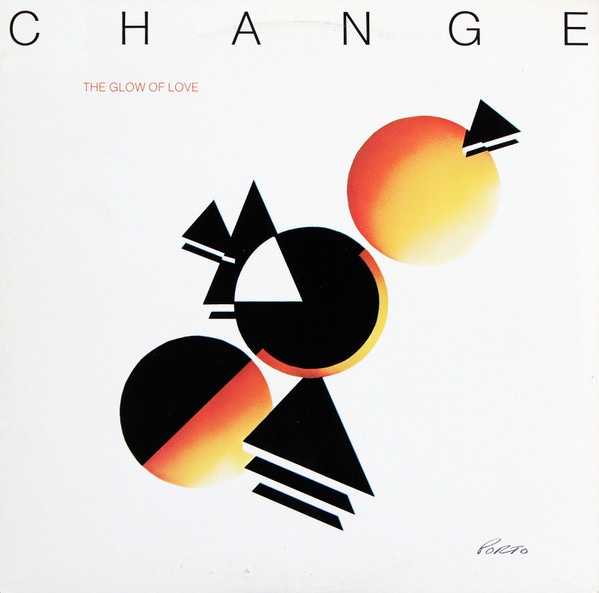
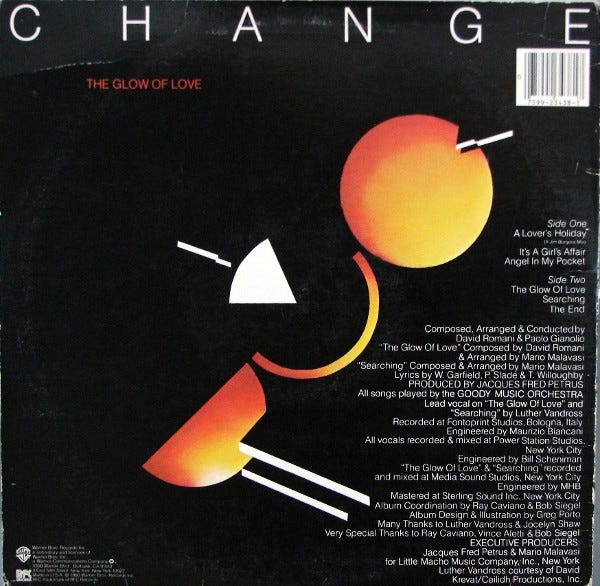
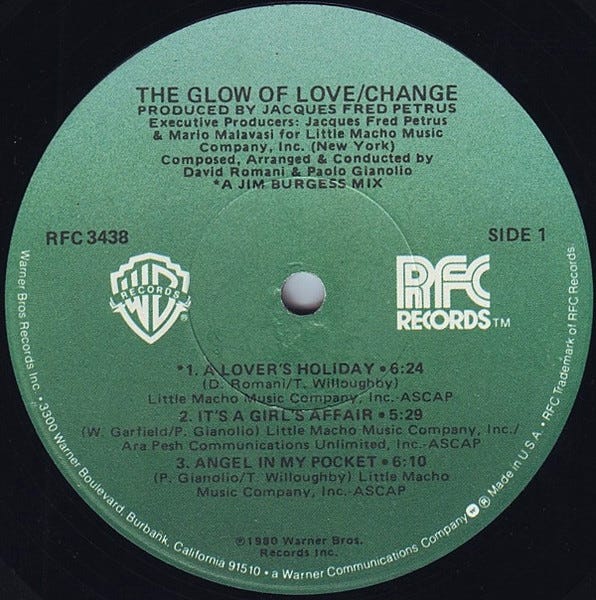
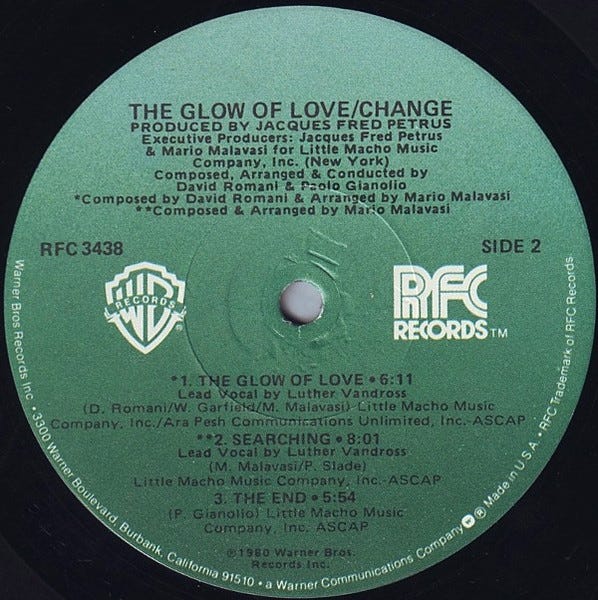
The debut album The Glow of Love, released April 1980 on RFC/Warner Bros., captured Change’s mission in six tight tracks. It was produced by Petrus and arranged by Malavasi’s team (Romani, Gianolio, etc.), and it introduced the world to Change’s “unique blend” of seductive Italo-disco and soulful American disco-R&B . Musically, the album is a lush collection of dance grooves with a strong Chic influence – polished funk rhythm guitars, bubbling bass lines, slick handclaps and strings – yet it also features electronic flourishes and Euro-disco sheen, especially in the synthesizer lines. The instrumentation (recorded entirely by Italian session players in Bologna) is precise and sophisticated, from the jaunty bass and brass on the opener “A Lover’s Holiday” to the delicate piano and string interplay on the midtempo title track.
Lyrically and thematically, The Glow of Love exudes positivity, romance, and escapism typical of post-disco optimism. The title track, for instance, celebrates the bliss of love in almost utopian terms. But what truly defines the album is its vocal performances. On side A, Jocelyn Brown leads the sassy “It’s A Girl’s Affair” and the funky “Angel in My Pocket,” delivering powerful diva vocals reminiscent of Chic’s Sister Sledge collaborations . Side B features Luther Vandross on the soaring “The Glow of Love” and the energetic “Searching”, which gave Vandross ample room to showcase his smooth yet dynamic range . The closing instrumental “The End” even nods to electronic music experimentation, with synth arpeggios that evoke Jean-Michel Jarre-style spacey ambience .
Production techniques on the album included state-of-the-art studio mixing at Power Station in New York to ensure the Italian-recorded tracks meshed seamlessly with the American vocals . The result, as AllMusic later noted, was “a disco/R&B masterpiece” – an album that plays like a continuous suite of elegant dance tunes . The Glow of Love was both a critical and commercial success. It reached #29 on the Billboard 200 and #10 on the R&B chart , and was certified Gold in the US . Critics praised the album’s cohesive sound; for example, Billboard in 1980 named it the #1 Disco album of the year (with Change topping year-end dance charts) . Key tracks became club anthems: “A Lover’s Holiday,” with its “shimmering, exuberant and funky” vibe, was a Top 40 pop hit and a #1 Disco chart hit ; “The Glow of Love” and “Searching” also both hit #1 on the Billboard Disco/Club Play chart in 1980 . In the UK, “A Lover’s Holiday” (backed with “Glow of Love”) reached #14 , and “Searching” hit #11 , making Change an instant presence in European clubs. With its sophisticated arrangements and transatlantic soul, The Glow of Love set a template that Change would both follow and experiment with in subsequent releases.
Miracles (1981)
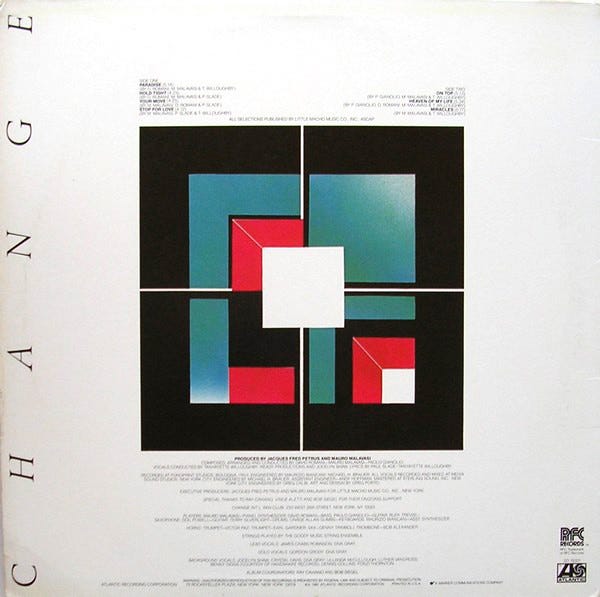
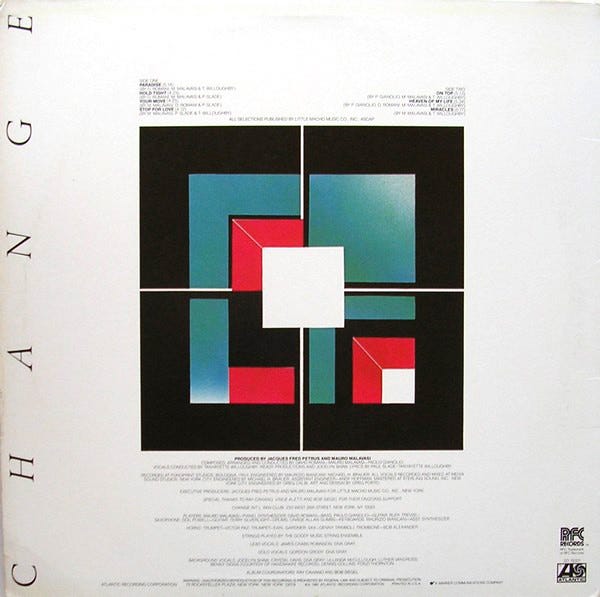
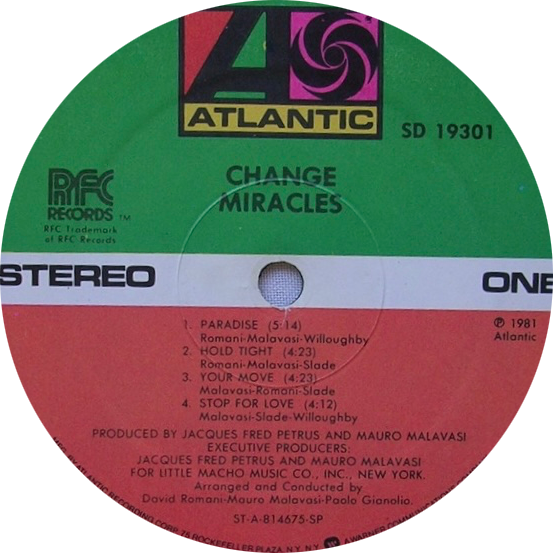

Change’s second album, Miracles, released in May 1981 (RFC/Atlantic), continued the formula of its predecessor but with some notable developments. The songwriting and production team remained largely the same – Malavasi, Romani, and associates – and the album again offers a mix of joyful uptempo tracks and smooth R&B. However, between albums Change had to contend with Vandross’s departure from lead vocals (contractual issues prevented him from singing leads on Miracles), so while Luther still contributed backing vocals on some songs, the group recruited James “Crab” Robinson as the new male lead . Jocelyn Brown also returned, alongside other session vocalists (including Diva Gray, Ullanda McCullough, and Fonzi Thornton from the Chic camp) . This gave Miracles a “revolving door” vocal cast, but Petrus and Malavasi ensured the overall sound stayed cohesive.
Musically, Miracles leans slightly more into electronic funk. The basslines grew a bit tighter and more synthesized (for instance, the driving electro-bass on “Paradise”), and there’s an increased use of synth brass and clap tracks, reflecting the trends of 1981. Yet, lush orchestration is still present – strings sweeten tracks like “Heaven of My Life,” and horn stabs accentuate the grooves. The album’s style can be seen as post-disco meets early 80s boogie: songs like “Hold Tight” are clearly inspired by Chic’s “Good Times” funk blueprint (Fonzi Thornton, who worked with Chic, even remarked that “Hold Tight” was reminiscent of “Good Times”) , whereas “Paradise” has an electronic dancefloor feel that foreshadows mid-80s R&B. Lyrically, the feel-good club themes continue (e.g., “Paradise” invites the listener to an idyllic dancefloor heaven).
Notable tracks and reception: Miracles produced three major club hits. “Paradise,” sung by Diva Gray, became Change’s highest-charting R&B single, hitting #7 on the Billboard R&B chart and also #1 on the U.S. Dance/Disco chart . It opens the album with an infectious energy – a quick bass pickup slides into a celebratory groove, accompanied by joyful vocals. “Hold Tight,” another single, slows the tempo slightly into a funk shuffle and features the Chic-esque group vocals; it too reached #1 on the Dance chart . “Heaven of My Life,” with shared vocals by Luther Vandross (in background), Jocelyn Brown, and others, is a mid-tempo groover with jazzy chords; it became a fan favorite and also topped the Club Play chart . James Robinson’s smooth tenor shines on the quiet storm ballad “Stop for Love” (which he leads) and the vibrant title track “Miracles” , giving the album emotional balance between dance tracks. Miracles was another strong seller, reaching #46 pop and #9 R&B in the US , and solidifying Change’s reputation. Critics noted that while it didn’t produce a crossover smash on the level of “A Lover’s Holiday,” it was “released to a similar level of success as the debut” in the club and R&B markets . The consistency of quality, despite new vocal personnel, showed the strength of Petrus and Malavasi’s production system.
Lead vocals on “Heaven of My Life”: Jocelyn Brown is the singer credited on the original LP sleeve. Some later references list Diva Gray, but most fans (and the official 1981 notes) cite Brown.
Sharing Your Love (1982)
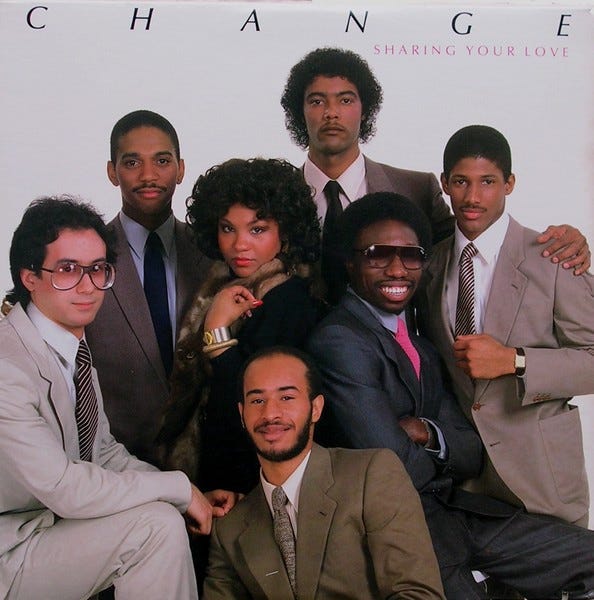
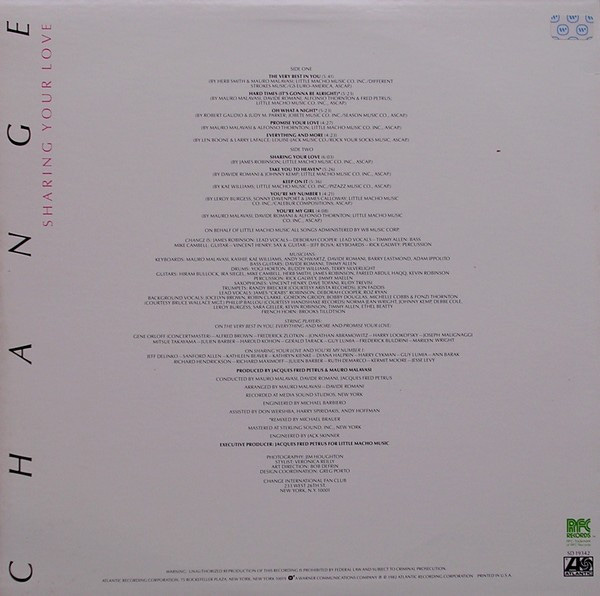

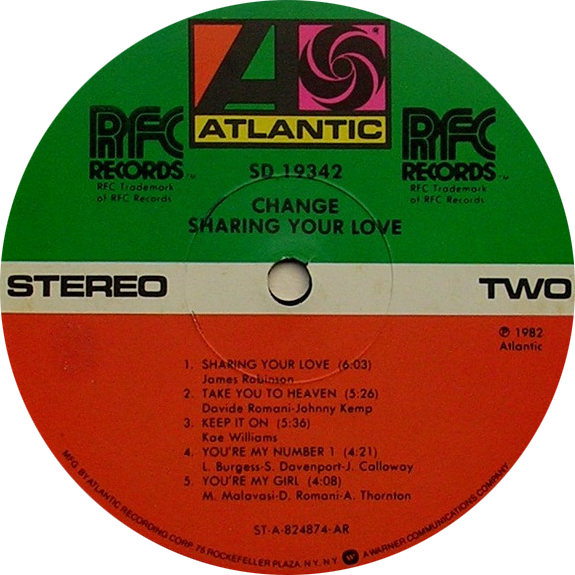
Released in 1982, Sharing Your Love marked a turning point for Change. This third album saw the group consciously move away from the pure “disco” label toward a more contemporary R&B/funk sound . By this time, Change had a more fixed lineup for recording and touring: James Robinson remained as lead male singer, and a core band of musicians had crystallized (bassist Timmy Allen, guitarist Mike Campbell, saxophonist Vincent Henry, keyboardist Jeff Bova, drummer Rick Gallwey, etc., many of whom were credited as the official band) . The presence of these American musicians in the studio gave Sharing Your Love a slightly different feel – arguably a bit closer to American R&B groups – though Malavasi and Romani were still involved in writing/production (albeit to a lesser degree, as Petrus opened up to other writers) . In fact, this album enlisted a wider range of writers, and Petrus allowed the new band members to contribute material, signaling a shift in creative process .
Musically, Sharing Your Love is less orchestrated and more synth-driven. The production uses bigger 1980s drum sounds and a “cooler” electronics-infused vibe . For example, the single “Hard Times (It’s Gonna Be Alright)” incorporates clipped, syncopated vocals (by Gordon Grody and Mic Murphy) and an upbeat message over a then-modern electro-funk arrangement – big drum machine beats and minimalistic synth lines – reflecting the early 80s urban funk trend . Still, the album balances these with classic Change elements: the lead single “The Very Best in You” (written by Malavasi/Romani/Slade) carries a pronounced Chic influence in its chic guitar riffs and celebratory vibe, even as its polished production edges toward 80s R&B . It became an R&B Top 20 hit (peaking at #16) and a club favorite . The title track “Sharing Your Love,” written and soulfully sung by James Robinson, is a smoldering, string-laden quiet storm ballad that showcased Change’s ability to do romantic slow jams . Another mid-tempo cut, “Promise Your Love,” co-written by Fonzi Thornton, blended traditional disco orchestration (strings, horns) with a more modern groove, illustrating the group’s hybrid of old and new .
While Sharing Your Love produced enjoyable songs, it did not hit with the same impact as the first two albums. The album charted at #66 pop and #14 R&B in the U.S. — a respectable showing but a downward trend. Critically, it received a more mixed reception; some contemporary reviews praised the funkier direction, while others felt the material wasn’t as strong save for its singles. In retrospect, the anthology notes describe it as continuing “a slowly declining trend in the commercial fortunes for the project” . Nonetheless, the album is notable for signaling Change’s adaptation: disco was truly left behind in favor of R&B/boogie. Sharing Your Love may be seen as a transitional album, bridging the Chic-style disco of early Change to the electro-funk of mid-’80s Change.
This Is Your Time (1983)
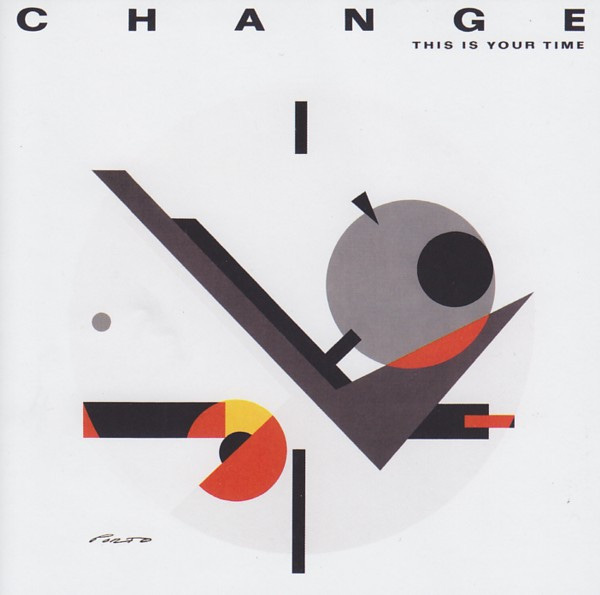
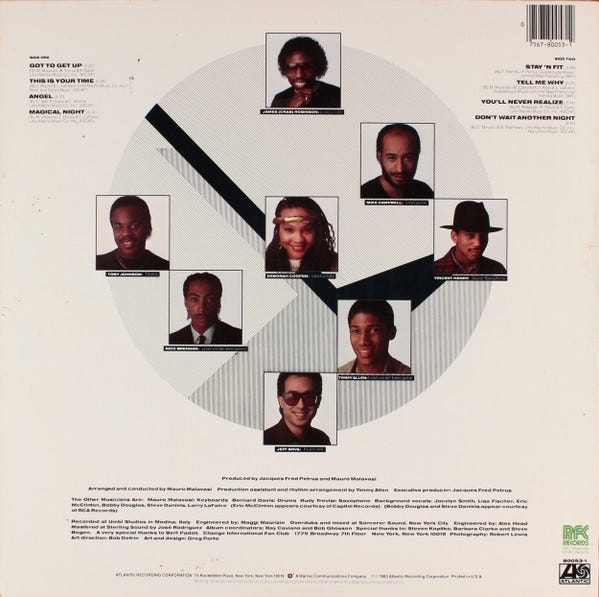
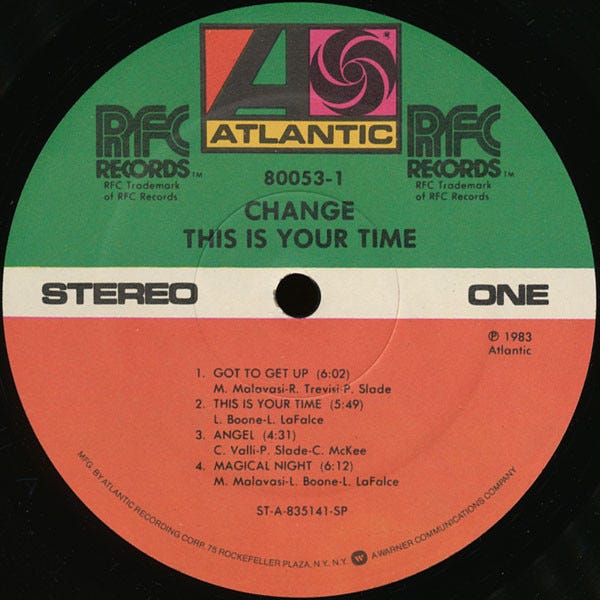
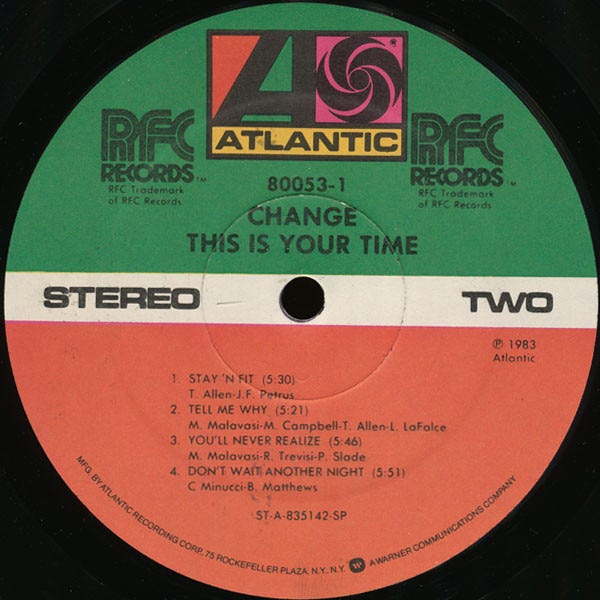
By 1983, Change faced both internal and external upheavals. Their fourth album This Is Your Time reflects this tumultuous period. Internally, Mauro Malavasi – the group’s chief songwriter/producer – parted ways with Petrus’s company during the making of this album, marking the end of an era . The lineup also shifted: James “Crab” Robinson nearly got replaced by newcomer Rick Brennan on lead vocals, but in a last-minute decision, Malavasi reinstated Robinson for most tracks, with Brennan only singing lead on two songs . Externally, music trends were rapidly evolving, with electro-pop and new wave funk in vogue, and This Is Your Time finds Change trying to modernize its sound accordingly.
The album is more electronic and stripped-down than any previous Change effort. From the first notes of the title track “This Is Your Time,” there’s a noticeable “electronic pulse” throbbing – a programmed synth bass and drum machine dominate the mix . The song is an upbeat motivational anthem (lyrics encouraging seizing the moment) with icy synths and a minimalist arrangement, very much in line with 1983 dance-pop aesthetics. Indeed, several songs here, like “Magical Night” and “Got to Get Up,” venture into synth-heavy territory that was “among the most heavily synthesized music released by Change to that point” . “Got to Get Up” in particular, one of the tracks sung by Rick Brennan, is noted for its sparse, electro-funk sound, almost a precursor to freestyle or electro R&B styles of the mid-’80s .
However, This Is Your Time arguably sacrificed some of the warmth and exuberance that characterized earlier Change albums. Critics observed that the “colder, more sterile sounds” on this LP didn’t showcase Change’s strengths . There are highlights: James Robinson shines on ballads like “You’ll Never Realize,” providing one of the album’s few soulful moments . But overall the album’s reception was lukewarm. It failed to generate a major hit; the title track peaked only at #33 on the R&B chart and didn’t have the club success of previous singles. The album itself barely made the Billboard 200 (#161) and was the lowest-charting Change album to date . Internally, it was clear that Change needed a reboot after this record – which Petrus promptly pursued by bringing in outside producers for the next album. In summary, This Is Your Time captures Change at a crossroads: the production is forward-looking (embracing drum machines and synthpop touches), but the inconsistent vocals and loss of the old writing team resulted in an album often seen as a creative dip for the group .
Track Listing: 1. This Is Your Time; 2. Magical Night; 3. Don’t Wait Another Night; 4. Got to Get Up; 5. Hold On (instrumental interlude); 6. You’ll Never Realize; 7. Lover’s Melody; 8. (varies by format, some editions have 7 tracks). (Lead vocals: James Robinson on most; Rick Brennan on “Got to Get Up” and one other; extensive use of synths and electronic instruments.)
Change of Heart (1984)

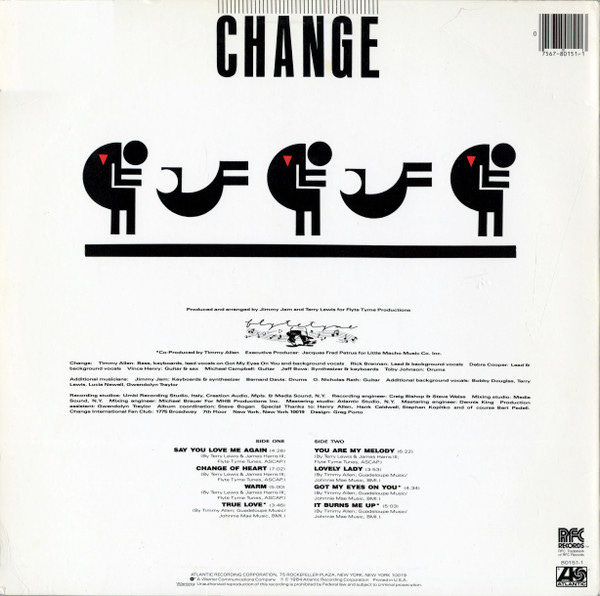


By 1984, Change underwent a major overhaul that yielded the album Change of Heart, one of their strongest late-period releases. After the relative disappointment of 1983, Petrus “wisely hired” two rising star producers from Minneapolis – Jimmy Jam and Terry Lewis (recently departed from The Time, Prince’s protege band) – to write and produce much of the new album . Jam & Lewis had been making waves producing soulful yet electronic hits for artists like the S.O.S. Band and Cheryl Lynn, and they brought that cutting-edge Minneapolis sound to Change. They flew to Italy to work on the project , collaborating with the revamped Change lineup: vocalist Rick Brennan (who finally got his moment as lead male singer), Deborah Cooper as lead female vocalist, and core band members Timmy Allen (now on bass, keyboards and also a songwriter), Vincent Henry (guitar/sax), Mike Campbell (guitar), Jeff Bova (keys), and Toby Johnson (drums) . This leaner unit, guided by Jam & Lewis’s fresh perspective, “reinvigorated Change.”
Musically, Change of Heart embraces mid-’80s R&B and funk trends wholeheartedly. The title track “Change of Heart” exemplifies the Jam & Lewis influence – a potent mix of funky electronic bass, sharp synth stabs, and catchy R&B songwriting. It’s an upbeat track with a hint of new-wave funk (burbling synths over a steady groove) and it “brimmed with confidence and focus” that the previous album lacked . The song became Change’s biggest hit in years, reaching #7 on the Billboard R&B chart (their first R&B Top 10 since “Paradise”) . Other Jam & Lewis contributions include “You Are My Melody,” a smooth mid-tempo jam that blends soulful group vocals with state-of-the-art 1984 production – one can hear the seeds of the sound Jam & Lewis would soon use with Janet Jackson . They also wrote “Warm” (a lush, upbeat groove led by Deborah Cooper) and “Say You Love Me Again,” a sweeping duet ballad (Cooper and Brennan) that adds heartfelt emotion to the album . Meanwhile, bassist Timmy Allen contributed the remainder of the songs, such as “It Burns Me Up,” a slick funk track with a glossy pop appeal , and “Lovely Lady,” etc., which fit neatly alongside the Jam/Lewis tunes.
Change of Heart as an album is tight (8 songs) and cohesive, with high production values. It successfully modernized Change’s sound without losing the soul – thanks to strong vocals from the new team and Jam & Lewis’s knack for combining electronic instrumentation with R&B melody. Critical and commercial reception was positive. The album returned Change to the charts internationally: it hit #102 pop, #15 R&B in the US and reached #34 on the UK Albums Chart . The single “Change of Heart” was not only a big R&B hit but also got significant club play and made the UK Top 20 (#17) . Follow-up singles like “It Burns Me Up” and “You Are My Melody” had more modest chart showings, but the album as a whole was seen as a strong comeback. Smash Hits magazine in the UK gave it a middling 4/10 , but in retrospect it’s often lauded for its consistency. This album proved that Change could innovate and adapt, incorporating the emergent Jam & Lewis Minneapolis funk style into their Euro-American blend. Notably, Jam & Lewis only stayed for one album (they would soon skyrocket in demand), but they left Change with an album that stands among the group’s finest.
Turn on Your Radio (1985)
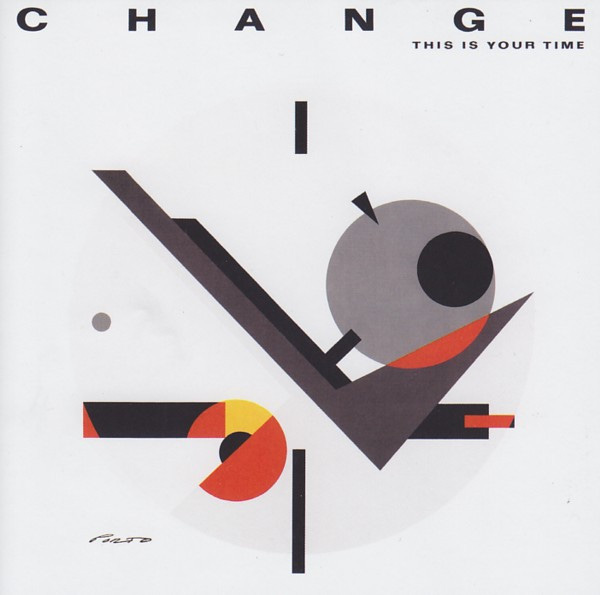
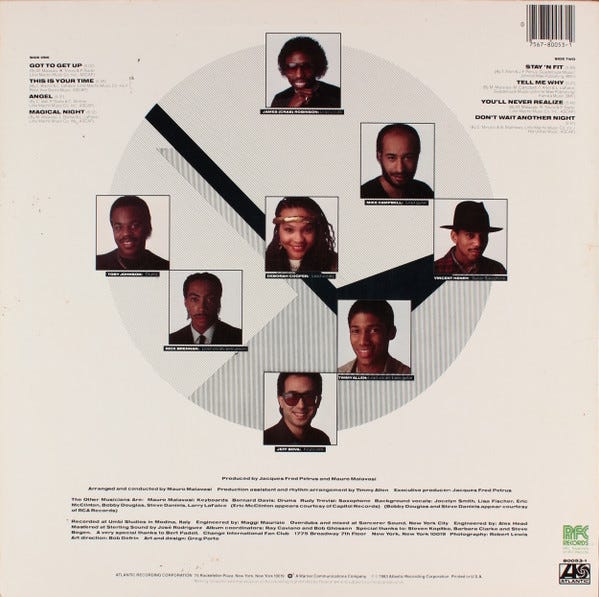
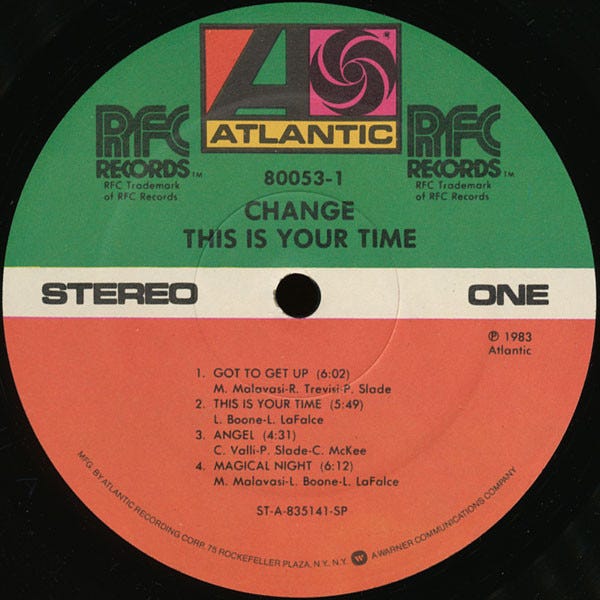
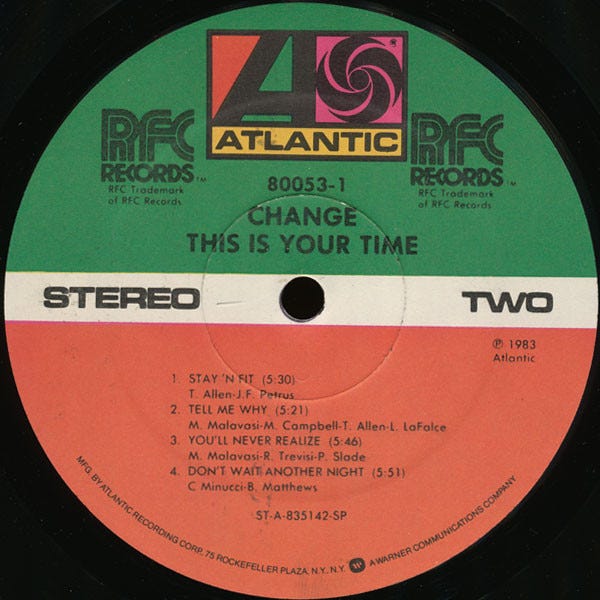
The sixth and, for decades, final studio album of Change’s original run was Turn on Your Radio, released in 1985. After Jam & Lewis’s departure, Petrus entrusted the production largely to Timmy Allen, effectively promoting the band’s bassist to the role of producer and chief songwriter . The lineup by now had pared down to Brennan (vocals), Cooper (vocals), Henry (guitar/sax), Campbell (guitar), with Allen not only playing bass but also keyboards and programming. This album continued in the general style of Change of Heart – contemporary mid-’80s R&B/boogie – but without Jam & Lewis’s input it leaned even more toward a straightforward urban dance-pop sound as envisioned by Allen.
Turn on Your Radio is characterized by synth-heavy arrangements and a somewhat lighter pop touch. Timmy Allen’s songs like “Mutual Attraction” have a glossy feel, blending pop melodies with danceable beats . “Mutual Attraction” in particular has an almost freestyle/adult contemporary vibe, indicating Change’s attempt to appeal to the mid-’80s pop market. There’s also the single “Let’s Go Together,” a sultry dance track with a hint of the Minneapolis sound carried over – it has a funky bassline and playful synth hooks. “Let’s Go Together” managed to give Change one last moment on the charts, reaching the Top 40 of Billboard’s Dance/Club Play chart in 1985 (and #56 on the R&B chart). Another track, “Oh What a Feeling,” tries to recapture the dancefloor magic with upbeat tempo and celebratory lyrics, though it charted modestly in the UK (#56) . The title song “Turn on Your Radio” is a smooth mid-tempo groove inviting the listener to enjoy music – a fitting final track that almost serves as a goodbye message from the band.
Despite continuity in style, Turn on Your Radio did not perform very well commercially. It only reached #64 on Billboard’s R&B Albums (missing the pop chart except bubbling under) . By 1985, musical tastes were shifting toward either drumming New Jack Swing (a few years later) or more synthpop oriented acts, and Change’s final effort, while competent, lacked the distinctive punch of earlier releases. Critics found it a bit generic; one retrospective comment noted it “bore little of the polished dance and R&B sound that the group had always emphasized” and was even less impactful than This Is Your Time . European audiences were somewhat more receptive – the album charted in the UK at #39 , and singles did modestly. But there was no denying that Change’s golden era was winding down. Unbeknownst to anyone at the time, Turn on Your Radio would be the last new Change album for 25 years.
Breakthrough Singles and Chart Performance
Throughout their career, Change released a string of singles that found success on various charts, particularly the U.S. R&B and Dance charts and in European markets. Below is a comprehensive list of Change’s singles from 1980–1985 and their peak chart positions:
Table: Change Singles (1980–1985) – Peak Chart Position
(Chart key: US Hot 100 = Billboard Pop; US R&B = Billboard Black Singles; US Dance = Billboard Disco/Club Play; UK = UK Singles Chart. A dash indicates the song did not chart in that territory or data is not available.)
Looking at the singles, Change’s breakthrough hits were concentrated in the early years. “A Lover’s Holiday” stands out as their biggest U.S. crossover hit, reaching #40 on the Hot 100 in summer 1980 . It was a smash in clubs, spending nine weeks at #1 on Billboard’s Disco chart and becoming the #1 disco record of 1980 , and it also performed well internationally (Top 20 in the UK and across Europe). Along with its flip side “The Glow of Love” and the follow-up “Searching,” Change was omnipresent on dance floors in 1980 – all three tracks were dance chart-toppers and remain staples of the post-disco canon. These songs fit perfectly into radio and club playlists of the time, which were looking for the next evolution of disco. Their slick production and joyous vibe made them favorites at venues like the Paradise Garage and on WBLS radio, bridging the gap between the late ‘70s disco era and the emerging boogie/funk era.
In 1981, Change proved they were not a one-album wonder with “Paradise.” This single became one of their signature tunes, hitting #1 on the U.S. Dance chart and #7 on the R&B chart . With its tight bass intro and Diva Gray’s soaring vocal, “Paradise” was a perfect fit for both radio and clubs, especially in the post-disco “boogie” scene that valued funk and sophistication. “Hold Tight” and “Heaven of My Life” further solidified Change’s dancefloor reputation; notably, as the Second Disc anthology liner notes recount, Change scored an impressive trio of #1 Club hits in a row with those three singles from Miracles . Even without major pop crossover, Change was a dominant act on dance charts – a testament to their resonance with DJs and dancers.
As the 80s progressed, some later singles had more regional or niche success. “The Very Best in You” (1982) did well on R&B radio (#16 R&B) , becoming a quiet storm staple with its smooth groove. However, Change’s presence on the pop chart faded after 1981, reflecting the American Top 40’s general shift away from dance groups during the early ’80s. In the UK and Europe, they maintained a following: for instance, “Change of Heart” (1984) not only was a big U.S. R&B hit but also made the UK Top 20, showing how the Jam & Lewis refresh rejuvenated their global appeal.
In summary, Change’s singles were most impactful in the club and R&B domains. They had five #1 hits on Billboard’s Disco/Dance chart (“A Lover’s Holiday,” “The Glow of Love,” “Searching” in 1980; “Paradise,” “Hold Tight,” and “Heaven of My Life” in 1981 – actually six if counting all those individually), and several Top 10 R&B hits across their catalog . Their songs like “The Glow of Love” and “Paradise” have endured, often featured on retro funk/disco playlists and still filling dance floors at soul/funk parties. These tracks also became a source of samples for future artists (see Section 8), underscoring their lasting appeal.
Touring, Performances, and Media Presence
One interesting aspect of Change is that, as a studio project, they were not initially conceived as a touring band – yet they did take steps to perform and promote their music live, especially after their early success. Following the release of The Glow of Love, Change remained mostly studio-bound; there is little evidence of a full tour in 1980, likely because the “group” at that time was just assembled for recording. However, the demand for live promotion led Petrus to “put together a group for promotion and live performances” after the first two albums . Around 1981–1982, a stable performing lineup coalesced (often referred to as the “second lineup”), which included James Robinson on vocals, Deborah Cooper, Timmy Allen, Rick Gallwey, and others from the New York contingent . This lineup undertook live gigs and TV appearances to give Change a public face. For instance, Change performed on music television programs in Europe; they lip-synced or played live for shows to promote singles like “Paradise.” There was even a Miracles Tour in 1981, according to retrospective accounts, which helped identify the members as an actual group rather than anonymous studio players.
Live, Change delivered polished performances that mirrored their studio sound. The instrumentalists from Italy and the U.S. recreated the tight grooves, and multiple vocalists would cover the complex backing arrangements. Reports from fans and snippets on YouTube suggest that Change shows often featured medleys of their hits (for example, “The Change Medley” was used as a B-side on later singles, possibly derived from live routines) . Still, being primarily a studio creation did impose challenges. One challenge was continuity of personnel – by the time of touring, Luther Vandross and Jocelyn Brown were no longer available, so their parts had to be covered by others (e.g., Diva Gray or other backing singers would sing Vandross’s sections during live sets). Additionally, Petrus’s multiple projects meant that some musicians were juggling roles (some members also toured with Petrus’s B.B.&Q. Band, another studio project).
In terms of media presence, Change did not have as high a profile in interviews or press as a traditional band might. Petrus himself stayed in the shadows (he was not a public figure like, say, Quincy Jones). However, Change did benefit from the emerging music video era. By 1984–85, promotional videos were made for songs like “Change of Heart,” giving visual identity to the group – in that video, the then-current members (Brennan, Cooper, etc.) are seen performing energetically, underscoring that Change had real performers. The group also appeared on television: for example, they performed on Soul Train in the U.S. (archive listings show Change appeared on Soul Train in 1980 performing “A Lover’s Holiday”) and various European TV music shows (Italy’s RAI programs, BBC’s Top of the Pops for “Change of Heart” likely, etc.).
Because Change was primarily a studio band, one limitation was the lack of a singular public persona or frontman. Unlike bands with a charismatic lead singer always present, Change’s lineup shifts could confuse casual audiences. By the mid-80s, when live performance became crucial for promotion, this may have put them at a slight disadvantage. Nonetheless, the quality of the music carried them, and they continued to tour through 1985 in Europe, often on double bills or at festival shows catering to funk and disco fans. It’s noted that since the 2000s, various incarnations of Change (with original or new members) have performed on the nostalgia circuit, demonstrating the lasting demand to hear these songs live.
In terms of media interviews, there are few from the original era – likely because Petrus managed multiple projects and kept a low profile. However, in later interviews reminiscing about the era, members like Deborah Cooper or Timmy Allen have spoken about their time in Change, highlighting both the exciting creativity and the relative anonymity of being in a “producer’s band.” In summary, while Change did break the studio-bound mold to some extent by forming a touring unit, their live and media presence was always secondary to their studio output. They thrived in clubs and on radio more than on the road, yet the decision to bring them on tour in the early ’80s did yield a more “real band” feel, which carried into the spirit of albums like Sharing Your Love.
Industry Impact and Reception
At the time of their releases, Change generally received positive attention within the dance/R&B music industry, even if mainstream pop critics were slower to take note. Critical reception for the debut The Glow of Love (1980) was strong: it was heralded in disco circles as one of the best albums of the year. Trade publications like Billboard praised the album’s consistent quality and dance-floor appeal (evidenced by it being the #1 Disco album of 1980). Luther Vandross’s contributions drew particular acclaim, with critics noting that his vocals on “The Glow of Love” and “Searching” were standout performances that augured his solo superstardom.
As Change progressed, critics continued to compare them to Chic – often favorably. Reviews frequently mentioned the Chic influence, sometimes suggesting Change was “Chic offshoot” or the European answer to Chic. Blues & Soul (a UK magazine) and Record Mirror gave good reviews to Miracles (1981), highlighting tracks like “Paradise” as top-tier post-disco funk. Not all reviews were glowing: Robert Christgau, the dean of American rock critics, gave Miracles a “B+” which, in his grading, meant a solid effort but perhaps lacking wider crossover.
By the third album, some critics and DJs noted a dip. The change in writing personnel on Sharing Your Love led to what one might call a “lukewarm” critical response. While the single “The Very Best in You” was well-received, some reviewers felt the album overall didn’t break new ground. There were no major awards or nominations for these middle albums, and one can sense that Sharing Your Love flew a bit under the radar compared to the excitement of the debut. This corresponds with the album’s more modest sales.
However, in 1984, the arrival of Jam & Lewis on Change of Heart brought renewed industry attention. Jam & Lewis were the hot new producers, and their involvement gave Change a fresh narrative. Change of Heart got significant coverage in R&B outlets: e.g., Black Echoes and Blues & Soul in the UK ran features on the album’s release. The title track’s success as an R&B top 10 was noted in Billboard. Critics felt the album smartly updated Change’s sound – Cash Box magazine, for instance, highlighted “Change of Heart” as a recommended track for radio programmers in 1984, noting its state-of-the-art groove. As mentioned, Smash Hits magazine gave it 4/10 , showing that not everyone was convinced – perhaps reflecting a bias against a studio group without star power. Nonetheless, Change of Heart is retrospectively considered one of their finest, and it reaffirmed Change’s relevance amid a changing music scene.
Industry impact: Change’s success and model had a subtle but real influence on how dance music could be produced. Petrus and Malavasi’s concept of a European-produced, American-sung ensemble opened the door for other transatlantic collaborations. In the early ’80s, other European producers (like the team behind Midnight Star in Belgium, or later Stock Aitken Waterman in the UK) saw that you could achieve authenticity in R&B/dance by bringing in American vocalists. Change also influenced the formation of studio-driven acts – their mold was mirrored by Petrus’s other projects (B.B.&Q. Band, High Fashion, etc.), essentially creating a mini-industry of studio bands. In interviews, Petrus stated that in shifting from disco to post-disco, they deliberately incorporated more R&B to “reflect the times” , indicating their thought leadership in genre evolution.
The group earned some industry accolades in the dance music community. Ray Caviano, head of RFC, touted Change as one of his label’s crown jewels. Change’s “A Lover’s Holiday” was named the Disco Single of the Year (1980) by Record World magazine. DJ Larry Levan of Paradise Garage famously included Change tracks in his sets (the fact that all three big songs from the debut hit #1 on the club chart underscores their embrace by influential DJs . In later years, the high esteem in which producers and DJs held Change was evidenced by the release of deluxe reissues: for example, in 2016, Groove Line Records put out Reach for the Sky: The Change Anthology with extensive liner notes and previously unreleased mixes – a treatment usually reserved for artists with a significant legacy.
Ultimately, while Change might not have won Grammys or American Music Awards on the level of some contemporaries, their critical legacy is secure among dance/R&B historians. They are frequently cited as one of the premier post-disco groups, and their early work in particular is often lauded. Their ability to thrive despite the “disco sucks” backlash (they scored hits in ’80-’81 when many disco acts fell off) is noteworthy . This resilience and adaptation mark them as innovators in the industry’s view. The European production model that Petrus/Malavasi perfected would become more common in the decades to follow (e.g., the globalization of dance-pop). In summary, within the niche they operated in, Change was and is regarded with respect – an act that delivered quality music and navigated the post-disco transition as well as anyone, leaving a blueprint for future studio projects.
Influence, Sampling, and Legacy
Change’s influence stretches beyond their years on the charts, affecting later genres like house and nu-disco and earning them a revered spot among connoisseurs of soulful dance music. One major aspect of their legacy is how frequently their tracks have been sampled and covered by later artists, especially those from The Glow of Love era:
The most famous example is Janet Jackson’s 2001 hit “All for You,” which prominently samples Change’s “The Glow of Love.” Jackson (with producers Jam & Lewis, who of course had worked on Change’s 1984 album) looped the distinctive guitar/bass groove of “The Glow of Love” as the foundation of her #1 pop single . This introduced Change’s sound to a new generation and underscores how timeless that groove is – even 21 years later it could drive a modern R&B/pop hit.
British dance duo Phats & Small scored a UK hit in 1999 with “Turn Around (Hey What’s Wrong with You)”, which heavily interpolates the melody and bassline of “The Glow of Love” . This track reached #2 in the UK charts, proving the riff’s enduring catchiness. (As one retrospective quipped, “we’ll overlook the fact Phats & Small sampled it” – a testament to how sacred the original is to fans, though the success of “Turn Around” undeniably broadened the legacy.)
Change’s music has been a wellspring for house music producers. Early house and garage DJs in the late ’80s often played the original Change records; later, producers directly sampled them. For instance, the deep house group Soul II Soul drew inspiration from the silky vibes of “Searching” for their own grooves. Masters at Work (Little Louie Vega and Kenny Dope), noted for blending house with live funk elements, have cited Change as influences and even remixed some of their tracks for DJ sets.
In hip-hop, 50 Cent sampled “The Glow of Love” in an underground mixtape track titled “The Glow” (1997), flipping Vandross’s chorus for a rap context . While not a major release, it shows Change’s reach into hip-hop sampling crates.
Beyond sampling, Change’s influence on later genres is evident in how their blend of electronic production with soulful vocals presaged the acid jazz and nu-disco movements. In the 2000s, nu-disco producers like Daft Punk and Aeroplane often cited late-’70s/early-’80s acts as inspiration; the post-disco vibe of Change – danceable yet song-oriented – is exactly the template many nu-disco artists emulate. Tracks like “A Lover’s Holiday” with its upbeat positivity and tight groove could slide into a modern nu-disco DJ set and feel right at home.
DJs and collectors hold Change in high regard. Vinyl originals of The Glow of Love or Miracles are sought-after. Their songs frequently appear on compilation albums: e.g., Ministry of Sound’s Anthems: Soul Weekend included “A Lover’s Holiday,” and countless “Boogie” and “80s Groove” compilation CDs have included Change tracks. This cements their status as classics of the genre. The Paradise Garage and Loft party communities revere cuts like “The Glow of Love” – they’re considered timeless anthems of the dancefloor. Indeed, in 2020, Rolling Stone ranked “The Glow of Love” among the 100 Greatest Disco Songs, highlighting its joyous spirit and Vandross’s vocal magic.
Change’s legacy is also preserved through reissues and tributes. All their albums have been remastered and re-released on CD (often with bonus tracks like 12″ remixes). Notably, in 2018, a compilation titled Love 4 Love: The Very Best of Change coincided with the band’s revival. There have even been tribute performances: at soul music festivals, it’s not uncommon to see a segment dedicated to Change’s hits, sometimes with original singers like Jocelyn Brown performing them. In recent years, original members Davide Romani and Mauro Malavasi returned to the studio to produce new music under the Change name (the 2018 album), which can itself be seen as a tribute to the style they created, updated for contemporary audiences.
Perhaps Change’s greatest legacy is the example they set as a truly transatlantic, multiracial collaboration in music. In an era when that was less common, they proved that great music could be made by combining the best of different worlds – sophisticated European arrangements and raw Black American vocal talent. This fusion influenced not just specific artists but the very approach of many producers after them. For instance, the Italian dance music scene continued to hire American vocalists through the ’80s and ’90s (the Italo-house scene of the late ’80s often featured U.S. gospel singers), a direct lineage from what Petrus started.
In sum, Change is remembered with fondness and respect by DJs, producers, and enthusiasts. Whether it’s being sampled in a chart-topping hit, played in a retro club set, or studied by musicologists as a key link in disco’s evolution, the music of Change still resonates today. Their songs – uplifting, musically rich, and dance-inducing – continue to bring people joy, living up to the band’s name in that they changed with the times and helped usher in new musical directions.
Socio-Cultural Context
To fully appreciate Change, one must place them in the broader narrative of the post-disco era and consider the socio-cultural dynamics of their formation. In 1979, disco in America faced a notorious backlash (“Disco Sucks”), which led major U.S. record labels to scale back on disco releases . Yet, even as the U.S. mainstream recoiled, new sub-genres were gestating: boogie (electro-funk) on one hand, and the early seeds of house music on the other. Change emerged right at this pivot point – 1979 into 1980 – effectively as part of disco’s evolution rather than its end. Their music, with slightly lighter kick drums and more emphasis on funk melody and electronic keys, exemplified how disco split into new styles like post-disco soul and boogie .
By producing tracks that were danceable but not dependent on the “loud bass-drum thump” of classic disco (to use the contemporary definition of post-disco soul ), Change helped define the sound of urban clubs in the early ’80s. They were contemporaries of acts like Kashif, Mtume, and D-Train, who were blending R&B with synths. But unlike those U.S.-based acts, Change had a distinct Euro touch. In Europe, disco never truly died in 1980; it morphed into Italo-disco and other electronic forms while remaining popular in clubs . Change’s success (particularly on U.S. Black and Dance charts) represented a cultural feedback loop – European producers inspired by American disco sending music back to America with American singers, effectively closing the loop between Eurodisco and American R&B.
Racially and culturally, Change’s story is compelling. The core producers and musicians (Petrus, Malavasi, Romani, etc.) were Italian (Petrus himself was a Black French Caribbean working in Italy, adding another layer), while the vocalists were predominantly African American. This collaboration occurred during a time when cross-cultural projects were not the norm. Petrus, as a Black West Indian in Europe, had an outsider perspective that perhaps made him bold in bridging cultures. He and Malavasi deliberately sought out Black American vocalists because they understood that the soulful authenticity and technical prowess of these singers would give their music credibility on R&B radio and in Black American communities. Indeed, part of the significance here is the agency of Black American artists in a transatlantic context – Vandross, Brown, etc., were not just session hacks; they imbued the music with gospel-rooted soul that European singers likely could not have matched.
There’s also a narrative of respect and homage: Italian producers like Malavasi revered American soul and funk (he was classically trained yet drawn to R&B). By layering Black vocals over their Euro arrangements, they were paying tribute to their influences while creating something new. It’s notable that in Italy, which has a smaller Black population, the image of a Black-fronted band performing music written by Italians turned typical cultural production on its head. One could argue this was an early form of globalized pop music – predating the worldbeat fusions of later decades.
Of course, there are complexities: Petrus’s production model has sometimes been viewed through a lens of exploitation – some have likened his rotating-cast studio groups to a factory assembly line. The vocalists were often uncredited on album covers (Change albums didn’t list Vandross or others as “members,” which might have denied them some spotlight). This raises questions about labor and recognition in such transatlantic projects. However, many of those singers later expressed gratitude for the opportunity. Vandross, for example, gained industry buzz partly through his work on “Glow of Love” – so the collaboration was mutually beneficial.
In the U.S., Change contributed to the continuity of Black dance music at a time of uncertainty. Their hits kept dancers moving in Black clubs from New York to Chicago. Sociologically, one could say they helped keep disco’s positive, inclusive spirit alive in the Black and LGBTQ club scenes even as mainstream rock audiences rejected disco. Tracks like “The Glow of Love” are remembered not just for their melody but for the feeling of unity and joy they brought to diverse dance floors – a key ethos of disco.
Transatlantic dynamics were also in play in the reception: Change was much more embraced by European pop markets than most American R&B bands. In the UK, for instance, they achieved chart positions and were featured on TV, partly because British audiences had always been more open to disco and because the “European-ness” of the production perhaps made them intriguing. They effectively blurred the lines of national identity in music – was Change an American group or Italian? The answer: both, and proudly so. They demonstrated that music could transcend borders: American R&B could be crafted abroad and still groove as hard as domestically-made records.
In sum, Change existed at the intersection of American soul and European disco. In a socio-cultural sense, they symbolized a collaborative spirit across race and nationality: Black and white, American and European, working together. At a time of disco demolition and new wave ascendance, they insisted that the funky, syncopated heartbeat of disco would live on, just in a new form. And by embedding Black American vocal identity in sleek Italian production, they gave the world a blueprint for many cross-cultural musical projects to come, showing that great music is a universal language – a lesson as relevant now as it was then.
Decline and Dissolution
By the mid-1980s, a combination of industry changes, shifting public taste, and internal dynamics led to Change’s fading popularity and eventual dissolution. One significant factor was the macro change in the music landscape: the mid-’80s ushered in New Wave, synth-pop, and the seeds of hip-hop and New Jack Swing, which began to dominate charts. While Change had successfully updated their sound in 1984, they were ultimately competing in a crowded field of funk/R&B acts (many of them American bands with stable identities like Kool & The Gang, or emerging young stars). The novelty of Petrus’s studio-band model may have been wearing off as well, especially without a consistent face for fans to connect with.
Internally, the group lost key creative forces. Mauro Malavasi’s departure after 1983 was a critical blow . Malavasi had been the musical mastermind; without him, Change relied on external input (Jam & Lewis) and then on Timmy Allen. While Jam & Lewis gave them a second wind, they only stayed for one album . When they left (understandably, as they became busy revolutionizing pop/R&B elsewhere), Change was somewhat adrift creatively. Timmy Allen did a commendable job on Turn on Your Radio, but as noted, that album lacked the spark of earlier efforts. Jacques Fred Petrus’s attention was also divided: by 1984–85, Petrus was juggling numerous ventures and perhaps dealing with personal troubles. There are reports that Petrus ran into financial difficulties and disputes with musicians over royalties around this time (the mid-’80s). These behind-the-scenes issues likely hampered promotion and investment in the band.
The commercial performance of Turn on Your Radio was disappointing – failing to crack the main charts significantly – which indicated the project had run out of steam. It “was even less successful than This Is Your Time,” essentially a commercial low point . Petrus apparently had plans to continue; Turn on Your Radio was not intended to be a swan song . But then external tragedy intervened: in 1987, Jacques Fred Petrus was murdered in Guadeloupe under mysterious circumstances (a likely mob-related assassination) . This shocking event abruptly ended the original Change project. Petrus was the linchpin holding together the international partnerships, and with his death, the infrastructure supporting Change collapsed.
Even before Petrus’s death, by 1986 the band had effectively gone on hiatus. The members scattered to other gigs. The mid-late ’80s were dominated by different sounds – Jam & Lewis themselves moved on to shaping Janet Jackson’s career, etc. A studio group like Change, without new material or a strong label push, simply faded from public view.
Additionally, market tastes had indeed changed: by 1986–87, even stalwart funk bands struggled unless they adapted to the emerging New Jack Swing style or adult contemporary R&B. Change’s brand of boogie-funk was seen as a bit dated by then. Also, the rise of the music video era meant that audiences expected visual personas and consistent group images – something Change, with its fluid membership, found challenging. The lack of a fixed charismatic frontman/frontwoman might have hurt their ability to sustain fan loyalty as trends shifted.
In retrospect, some also point out that Petrus’s business model had a built-in weakness: he did not strongly develop individual stars within Change (because he rotated talent). So when the concept lost novelty, there wasn’t a marquee name to carry it forward. For example, Vandross left and became huge on his own; had he stayed, perhaps Change would have remained a household name, but then it wouldn’t have been Petrus’s interchangeable project anymore. It’s an interesting “what-if,” but Petrus intentionally avoided letting the band become about one star, and that may have hastened its end once the formula’s returns diminished.
By the late ’80s, the Little Macho Music empire Petrus built (which included Change, the B.B.&Q. Band, High Fashion, etc.) had unraveled. Change’s dissolution was part of that larger collapse. It’s telling that the formal end is pegged to Petrus’s death in 1987 – without him, no new Change albums were attempted for some time (until Romani’s revival effort years later).
In summary, Change’s decline was due to a confluence of: the natural arc of a project that had run for six albums; the departure of key creatives (Malavasi, Jam & Lewis); increasing competition and changing styles in mid-’80s R&B; and the unfortunate loss of Petrus. Timing also played a role – had they come a few years later, maybe the house music explosion could have carried them; a few years earlier, maybe they’d have been bigger pre-backlash. But they operated in a narrow window. They left behind a strong legacy (as covered above), but by 1986 the innovative spark had dimmed, and the group quietly ceased active work, only to be nostalgically remembered until a later revival attempt.
Where Are They Now?
After Change’s original run ended, the various members and collaborators each went on to diverse paths, with some achieving great success in music:
Luther Vandross: Arguably the most famous alumnus of Change, Vandross launched a hugely successful solo career starting in 1981. His debut album Never Too Much (1981) went platinum, and throughout the ’80s, Luther became one of R&B’s biggest stars, known for his silky ballads and dynamic live performances. He won 8 Grammy Awards over his career and sold millions of records. Vandross occasionally acknowledged his time with Change as a stepping stone; diehard fans often point newcomers to “The Glow of Love” as an early showcase of his talent. Sadly, Luther Vandross passed away in 2005, but his legacy as a soul legend endures, and indirectly so does Change’s through him (e.g., any retrospective on Luther mentions that one of his first leads was with Change .
Jocelyn Brown: After leaving Change, Jocelyn Brown continued to be an in-demand session vocalist and achieved solo success. In 1984, she had a UK Top 10 hit with “Somebody Else’s Guy,” a dance-soul classic that remains her signature song. Brown became a beloved figure in the UK and European dance scene, often featuring on house tracks in the ’90s (e.g., she voiced the immortal line “I got the power” in Snap!’s hit “The Power,” albeit sampled). She still performs internationally, her voice remarkably powerful as ever, often including Change songs like “Searching” in her live repertoire.
James “Crab” Robinson: James Robinson pursued a solo career after leaving Change in 1983. In 1987, he released a solo album Guilty on Tabu Records (the same label as the S.O.S. Band), which was a solid effort but did not attain major commercial success. He did score a minor hit with “Can We Do It Again” on the R&B charts. Robinson also did songwriting and session work; notably, he sang on some early ’90s projects (like background vocals for other artists). In later years, James Robinson stepped away from the spotlight. There’s an enduring respect for his work with Change, and occasionally he’s involved in nostalgia shows (some reports have him appearing in Petrus tribute events in the 2000s).
Deborah Cooper: After Change dissolved, Deborah Cooper’s career took off in the dance music world. In the late ’80s, she became a vocalist for the group C+C Music Factory (and its predecessor project, Clivillés & Cole), though initially behind the scenes. She famously sang (uncredited at first) on C+C Music Factory’s “Deeper Love (Pride)” in 1992 and toured as their lead vocalist, finally getting due recognition. Cooper became known as a top session singer for dance/house tracks and continues to perform, especially in the freestyle and house circuits. She is often introduced as “formerly of Change” and “C+C Music Factory vocalist” in shows.
Davide Romani: The bassist and co-producer extraordinaire, Davide Romani remained active in music production after the mid-’80s. In the late ’80s, he worked in Italy on various pop and dance projects. Notably, Romani teamed up with guitarist Mike Francis and singer Patrick Boothe around 1990 in an attempt to revive Change. They recorded a number of tracks intended for a new album under the name “X-Change” . However, due to budget issues, the project was shelved at the time . Those recordings eventually saw the light of day in 2009, when Romani struck a deal with Fonte Records to release them as an album titled Change Your Mind . Romani produced and co-wrote this album, effectively bringing back the Change moniker after two decades (though with a new vocalist, Boothe, as the frontman). In 2018, Romani was also instrumental (along with Malavasi) in assembling the new lineup of Change (see below). Thus, Romani has stayed closely tied to the Change legacy and Italian R&B music, and he continues to work behind the scenes in production.
Mauro Malavasi: After departing Change in 1983, Malavasi returned to Italy and shifted focus. He notably became a producer for Italian pop and classical crossover projects. A major highlight: Malavasi co-produced and co-wrote for Andrea Bocelli, the famed tenor. He worked on Bocelli’s breakthrough album Romanza in 1997 and subsequent albums, crafting hits like “Con Te Partirò” (Time to Say Goodbye) . This is a completely different realm from disco, showcasing Malavasi’s versatility. He also produced for Italian artists like Lucio Dalla and Gianni Morandi .Though Malavasi stepped away from dance music for years, he never forgot his roots; in 2018, he reunited with Romani to bring Change back (serving as executive producer/co-producer for the new album). Today Malavasi is recognized as one of Italy’s top arrangers and producers, with a career spanning from funk to opera.
Jacques Fred Petrus: Petrus’s story ended tragically. After the mid-’80s, his fortunes declined. Some of his later projects (like attempts to break into the mid-’80s high-energy scene) didn’t pan out. In 1986, facing financial and possibly criminal pressures, Petrus returned to his native Guadeloupe. In June 1987, he was murdered there at age 39. The case was never fully solved, but it’s widely speculated to be a hit related to unpaid debts or underworld connections. Petrus’s death marked the end of an era; he was later acknowledged as a “hidden architect of black music history”, as one writer put it, for his pioneering role in post-disco production . Petrus died before seeing the revival of interest in his work, but posthumously he has received credit in articles and books on dance music history.
Timmy Allen: After Change, Timmy Allen became a very successful producer and A&R man in the late ’80s and ’90s. He joined Jive Records’ production roster and worked with big acts. For example, he co-produced Stephanie Mills’ 1987 #1 R&B hit “(You’re Puttin’) A Rush on Me” . He also produced for the Backstreet Boys in the ’90s (yes, the boy band – showcasing how he transitioned into pop) . Allen was involved with artists like Hi-Five and LFO as well. In essence, he took the studio chops he honed with Change and translated them into a behind-the-scenes career that yielded multiple hits and he became an A&R executive. In recent years, Timmy Allen has run his own label and continues in music production.
Other members: Rick Brennan (the ’84-’85 vocalist) returned to session work and songwriting. Vincent Henry(sax/guitar) became a respected session saxophonist, playing with artists like Luther Vandross and Marc Anthony. Jeff Bova (keyboardist) went on to great success as well – he became a Grammy-winning producer (worked on Celine Dion’s “Falling Into You” album among many other projects) and is a top arranger in pop/rock. Many of the backing singers (like Fonzi Thornton, Michelle Cobbs, etc.) continued their busy careers in the NY session scene.
2010s Revival: In 2010, as mentioned, the shelved “X-Change” album was released as Change Your Mind, giving fans essentially a “lost” Change album with Romani’s signature songwriting (though this album features a more late-80s sound, since it was recorded in 1990). Then in 2018, Change officially reformed. Under the guidance of Romani and Malavasi, and with licensing from Warner, they released a brand new album called Love 4 Love. They recruited American vocalist Tanya Michelle Smith as the new lead singer, thereby maintaining the tradition of a Black American voice leading the music . The album was released in September 2018 and even had a single “Hit or Miss” with a music video . The new Change lineup also performed live, effectively bringing the music full circle for new audiences. While this revival is relatively recent, it speaks to the enduring nature of Change’s music that core members in their 60s (Romani, Malavasi) felt compelled to create new material under the famous name and that they found an audience eager to hear it.
In conclusion, the individuals behind Change have left an indelible mark across the music industry – from Luther Vandross’s superstar legacy, to Malavasi’s cross-genre production triumphs, to the numerous hits crafted by alumni like Timmy Allen and Jeff Bova, to the ongoing appreciation kept alive by Romani and others. Change, as a group, might have paused for a few decades, but the people who made Change never really stopped changing the music world in one way or another.
Conclusion
Why does Change matter? In the pantheon of soul, funk, and disco innovators, Change holds a rightful and unique place. They were more than just a studio concoction or a footnote of the post-disco era; they were a bridge between musical worlds – linking the glitter of late ’70s disco to the groove-oriented R&B of the ’80s, connecting European studio craft with African American performance genius. In doing so, Change helped pioneer a new model for dance music and left behind recordings that still sparkle decades later.
Change’s music resonates because of its timeless quality. The combination of catchy melodies, lush arrangements, and heartfelt vocals gives songs like “The Glow of Love” and “A Lover’s Holiday” an enduring appeal. These tracks exude joy and sophistication; when you listen, you are transported to a feel-good place – a dance floor where the rhythm is infectious and the positivity palpable. It’s no surprise that modern artists continue to sample these songs or that DJs still spin them to ignite crowds. The music was meticulously crafted to sound good – and it still does. As the Reach for the Skyanthology in 2016 demonstrated, when remastered, Change’s tracks have a “stellar, punchy sound” that holds its own against any era . The anthology also positions Change as a key narrative in dance music’s evolution “from classic disco to more electronic sounds,” showing how they thrived despite the odds of the disco backlash . In essence, Change changed with the times and helped shape those times.
Narratively, the story of Change is inspiring. It’s a story of transatlantic collaboration that was ahead of its time, of a collective of musicians who despite not being a traditional band managed to produce art at a very high level. It’s the story of Luther Vandross’s early breakout, which in itself is a significant chapter in R&B history – thus, anyone exploring Luther’s roots finds in Change a treasure trove. It’s also the story of an entrepreneurial producer (Petrus) who dared to do something different and succeeded, until he didn’t – a rise and fall that has almost a mythic quality in music industry lore (Vice even ran an article calling Petrus’s saga one of ruthless rise and assassination ).
In the grand scheme, Change matters because they exemplify the innovation and resilience of Black dance music. They proved that disco didn’t die – it evolved. And they were among the ones evolving it, keeping the flame burning in a difficult time and influencing the next wave (one can draw a line from Change to the emergence of house music – the DNA of their grooves is in many early house tracks that employed similar basslines and arrangements). They also matter as part of the Italo-disco lineage – American audiences might not realize it, but Change was essentially an Italo-disco band (as Wikipedia even notes ), and one of the most successful at that, showing that Italian musicians could score hits in the American R&B world – a significant cultural crossover.
Finally, Change’s music still resonates because of its positivity and musical richness. In an era where music production can be very computerized, the organic yet polished sound of Change is refreshing to new ears. Young listeners discovering them today often react with “I can’t believe this song is 40 years old!” That’s the hallmark of classic status. And thanks to the 2018 revival and ongoing reissues, Change’s catalog is readily accessible, allowing their legacy to continue growing.
In closing, Change deserves to be remembered as one of the premier ensembles of the post-disco period – a group that lived up to its name by constantly adapting and delivering quality. They brought together East and West, North and South, black and white, American and European, in a fusion that transcended all those boundaries and simply gave us great music. On dance floors and in headphones, in samples and in original form, the glow of Change’s music remains undimmed, testifying to their important place in music history.




